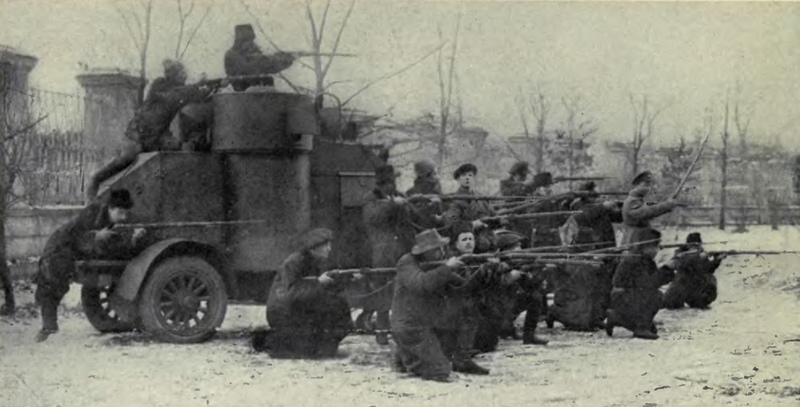100 years ago, the world was shaken by the October Revolution. We rightly celebrate this heroic act as the first instance of workers’ power in history. But how exactly did the Bolsheviks and the working class exercise a power never-before wielded by the proletariat? What problems did they face – economic, administrative, political and military, from within and outside Russia – and how did they meet them? Derek Gunby provides an analysis and balance sheet of 1918: the first year of the Russian Revolution.
1918 proved to be one of the most tumultuous and violent years the world had ever seen. Not only were vast armies from all countries and continents fighting a gruesome World War but also the victorious Russian Revolution of October 1917 was facing a huge wave of internationally financed armies, Russian and Foreign, dedicated to its overthrow. By the end of the year the World War was over. The Bolshevik-led workers and peasants government of Russia had withstood all possible trials to secure a vital foothold for the revolution and begin the long task of defeating all the elements of armed counter-revolution. Much remained to be done and it wasn’t until 1921 that Soviet power had been fully consolidated in all of Russia. This article traces the key events and identifies the main challenges facing the revolution in 1918, the decisive role of the Bolshevik Party and its leaders and the lessons that remain for us today.
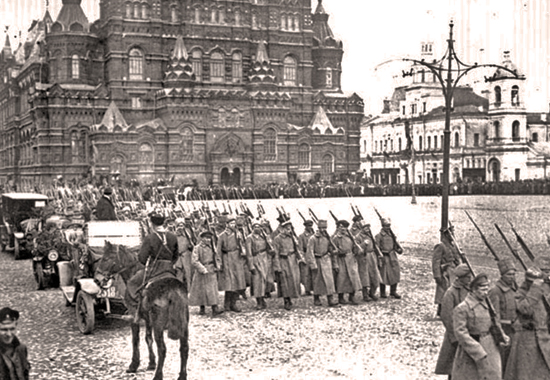 The Bolshevik-led workers and peasants government of Russia withstood all possible trials to secure the revolution / Image: public domain
The Bolshevik-led workers and peasants government of Russia withstood all possible trials to secure the revolution / Image: public domain
A revolution involves a tremendous clash of class interests, as has happened at various junctures throughout human history, such as the English Revolution of 1642, the French Revolution of 1789, the Paris Commune of 1871 and then the Russian Revolutions of 1917. These are rare events that are important to understand for all those interested in human affairs, but especially Marxist revolutionaries who seek to change the world bourgeois order to a working class order that will pave the way for a classless society.
Revolutions are the highest expression of historical change. They mark a qualitative change in the development of human society. During such revolutions the masses enter into direct political action. In the normal course of events politics is conducted by relatively small numbers of people representing class interests. But, in a major revolution, such as occurred in Russia in 1917, large numbers of ordinary people throw off such inhibitions and directly participate to achieve a transfer of power. However, it also requires a conscious and clear-headed political agency with a political programme to channel and direct this creative energy to transform society.
As revolutionaries, our aim is to be a part of that critical political agency. We need to arm ourselves with past experiences to guide future action. We need to understand the processes that occur during a revolutionary period. These lessons cannot be applied mechanically but must be refracted through the prisms of subsequent history and our current experience. Nothing is ever repeated exactly. We take from the past and test its relevance and application today to see how this may offer some guidance as to how to adapt effectively to our own age.
Russia at the end of 1917
The Russian Empire at the end of 1917 was a huge conglomeration of nationalities and ethnic groups covering millions of square miles from the Pacific Ocean in the east to the Baltic and Black seas in the west. With a population of over 178 million people it was overwhelmingly a rural and agrarian society. Eighty percent of the population was composed of peasants living for the most part in scattered villages with poor communications between them. To the Russian peasants, the village and surrounding fields was, for all practical purposes, their world. Whilst in 1861 the peasants had been freed from serfdom, the legislation doing so had failed to modernise and develop agriculture and the conditions of the peasants still lagged way behind most other comparable European countries.
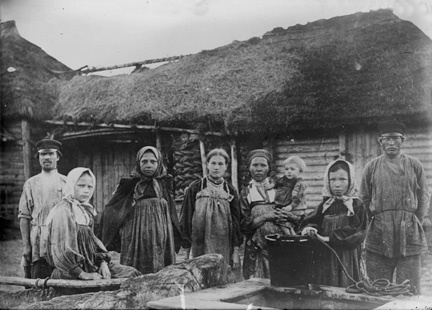 Russia in 1918 was mostly a rural and agrarian society / Image: public domain
Russia in 1918 was mostly a rural and agrarian society / Image: public domain
Industry was concentrated in a few areas such as St. Petersburg and Moscow, with oil production in Baku in the south and coal mining in the Ukraine’s Donets Basin. A great proportion of the industrial capital was owned by foreign interests especially in St Petersburg, and the national capitalist class was both weak and divided, with much of it heavily dependent on the state. Some of its factories were very modern and even by world standards extremely large, especially in the capital St. Petersburg. This created a relatively compact and concentrated working class, much of it recruited relatively recently from the villages.
Nationalities
The Russian Empire consisted of a large number of different nations that had, over the years, been conquered and suppressed by the Russian Tsarist state. These comprised, among others, the Baltic States, Poland, Finland, the Ukraine, the various Caucasus States such as Georgia, Belorussia, Bessarabia, and a number of Asian States such as Kazakhstan, Turkmenistan and others. Nationalism was, therefore, a potent force within Russia and something that required a response from all socialist parties.
This issue had provoked considerable debate in Marxist circles. It demanded creating federated socialist states on the basis of of international socialism in addition to the more immediate question of throwing off the yoke of Russian imperialism. Lenin’s approach was practical. He recognised, unlike Rosa Luxemburg, that in order for the working class to achieve victory in an empire of oppressed nationalities, they had to win over those masses, often peasants and other petty-bourgeois classes, by adopting the principle of the right of all nations to self-determination. Without this approach the task of the Socialist Revolution in Russia would have been impossible.
The Russian Orthodox Church
The power and wealth of the Russian Orthodox Church was considerable. But it was strongly linked to the Tsar and the old Imperialist order. Whilst it had held tremendous sway over the peasant masses, the experience of the First World War and the growing disapproval of the Tsar caused a significant loss of its authority. During the counter-revolution and civil war the Church unreservedly backed the reactionary forces, leading to an even greater weakening of loyalty from the masses. Its power, wealth and influence were considerably reduced by new Bolshevik government decrees confiscating Church land and privileges and restricting its operations and influence.
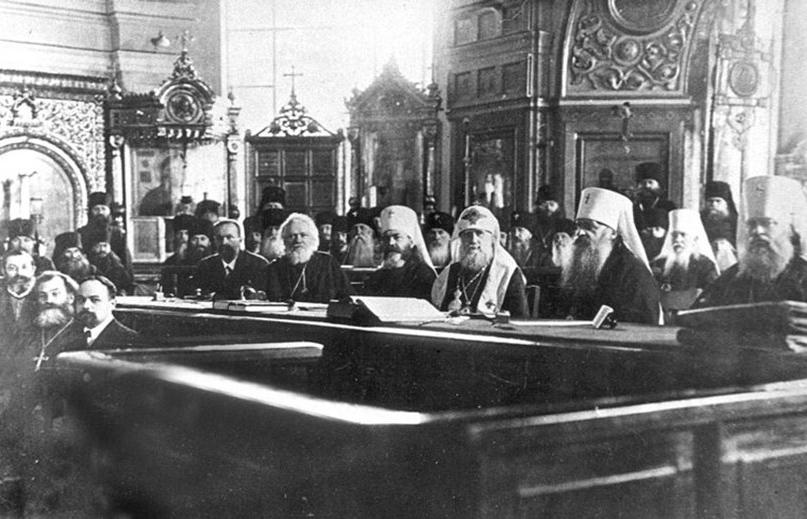 During the counter-revolution and civil war the Church unreservedly backed the reactionary forces, weakening the loyalty of the masses / Image: public domain
During the counter-revolution and civil war the Church unreservedly backed the reactionary forces, weakening the loyalty of the masses / Image: public domain
Classes and conditions in Russia in late 1917
Russia in late 1917 was clearly in crisis. The country had been involved in a devastating World War for three years. The soldiers were weary and rebellious, prone to mutiny, with many deserting and returning to their peasant homes. The Provisional Government that followed the February Revolution failed to tackle any of the acute issues of war, food or land and was plainly ineffective. The economy and general morale of the country was in tatters. The motor for change in Russia was the relatively small but powerful working class. They had organised themselves in Soviets that became a parallel power to the Government. The old governing structures of the State and local Dumas became the last redoubts of the bourgeois class, allied with some of the remnants of the old aristocracy.
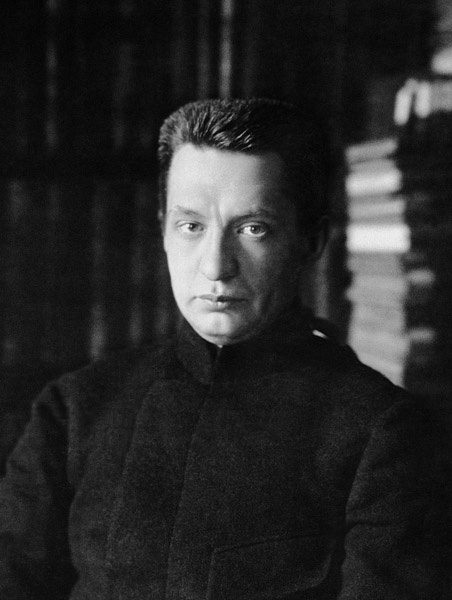 The Provisional Government that followed the February Revolution failed to tackle any of the acute issues of war, food or land / Image: public domain
The Provisional Government that followed the February Revolution failed to tackle any of the acute issues of war, food or land / Image: public domain
The bourgeois class – the bankers, capitalists, big business managers and senior civil servants – was small, though relatively wealthy and with access to resources. However, it lacked the weight and history of similar classes in Western Europe and the USA. The Russian bourgeois had been denied a full place in government due to the backward nature of the Russian state. Whilst they gained leading positions in the first Provisional Government after the February Revolution, they proved weak and ineffective. The vast peasantry was not homogenous but, rather, split into rich, middle and poor peasants with the poorest, often landless, by far the larger proportion. Most peasants were poorly represented in governing structures. Local administration remained in the hands of the large landowners and their supporters, including rural merchants and businessmen and kulaks (rich peasants).
The Red Guards
Armed workers’ militias, known as the Red Guards, had emerged at the time of the February 1917 Revolution, often in spontaneous form. Various factories and political parties sought to encourage and develop such units. The Bolsheviks were the most successful and ardent in promoting the idea of armed workers militias. There was a suppression of the Red Guards after the events of July 1917 but this was reversed in September in the face of the threat to the Provisional Government by General Kornilov, and the forces under his command, who were then threatening Petrograd. The Bolsheviks were entreated to assist the resistance and rapidly mobilised and armed 25,000 Red Guards. After that, the Red Guards remained a key feature of future struggles in all the major cities and at the moment of the October Revolution, numbered 200,000. After the revolution, the Red Guards performed the functions of the police and army until such times as new police and Red Army units were constituted, sometimes quite late into 1918.
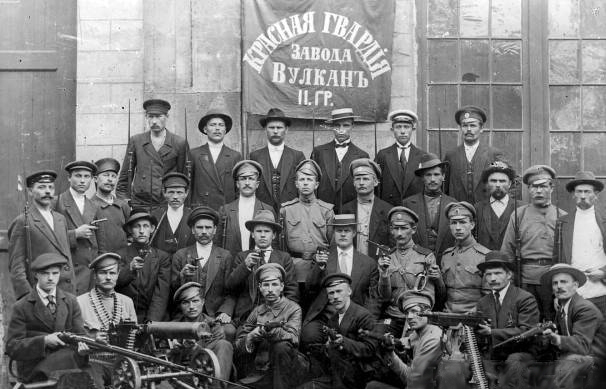 After the revolution, the Red Guards performed the functions of the police and army until new police and Red Army units were constituted / Image: public domain
After the revolution, the Red Guards performed the functions of the police and army until new police and Red Army units were constituted / Image: public domain
Political Parties and Leaders
By the autumn of 1917, the Bolsheviks had gained a majority following among the urban working class but had a minority position in the countryside. The Bolshevik Party had a number of strong distinguishing features that gave it a unique strength in the conditions of Russia in late 1917 and into the turmoil of 1918. They had a grounding in Marxist theory, especially dialectical thinking, which allowed them to analyse events from all angles and uncover the underlying forces that such events represented.
There was no culture of rigid and uniform thinking in the Bolshevik Party. In the heat of the revolution there were initially several splits and occasionally resignations and later re-joining. Lenin, outstanding as the most sober, the most realistic, the chief dialectician, and Trotsky, also a great dialectician, proved to be head and shoulders above all other Bolshevik leaders in their capacity to analyse events and urge decisive action. Within the Party there was a strong tradition of internal democracy and debate. Leaders were acknowledged but opposed if they were thought to be wrong. Conversely, leaders accepted decisions that went against them, even if continuing to oppose them in debate. This pertained even in the darkest hours and throughout 1918 and up to 1924, when Lenin died and Stalin took the reins and changed this key Party principle. Once Lenin arrived back in Russia in April 1917, the Party developed great élan and confidence, which they transmitted to the working class and spurred heroic efforts to protect and advance the revolution. The Bolsheviks embodied the aspirations of the most advanced layers of the working class and utilised their skills and energy. This convinced ever-widening layers of workers, soldiers and poor peasants of the value and aims of the Bolsheviks.
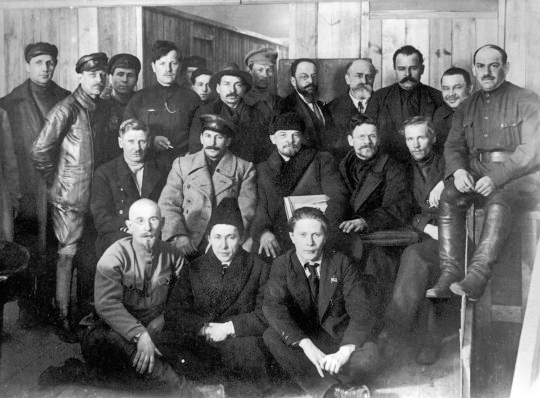 By the autumn of 1917, the Bolsheviks had gained a majority following among the urban working class but had a minority position in the countryside / Image: public domain
By the autumn of 1917, the Bolsheviks had gained a majority following among the urban working class but had a minority position in the countryside / Image: public domain
The Social Revolutionary Party (SR) was founded in 1902 and was a member of the Second International. The Party was an amalgam of various influences, including some Marxism and some of the ideas of the old populist and terrorist group the Narodniks, but were primarily a reformist party with a focus on land reform. Unlike the Bolsheviks, the SRs placed an emphasis on individual, rather than collective outcomes for successful land reform. It was essentially a peasant-based party and thus tended to vacillate between the classes in its positions, since the peasantry is composed of scattered and heterogeneous elements, some much richer than others. In 1917 it was the majority party of the countryside with strong support among ordinary soldiers, who were in the main of peasant origin. They played a major role in the formation and leadership of the Soviets, albeit in most cases playing second fiddle to the Mensheviks.
After the February 1917 revolution the SR Party became a major component of the new Provisional Government. As that Government moved to the right under the pressure of events and Kerensky took the reins of power, the left faction of the SRs, led by Maria Spiridonova, began to establish a separate position, more sympathetic to the Bolsheviks. At the Second Congress of Soviets in October 1917, when the Bolsheviks proclaimed the deposition of the Provisional government, the split within the SR Party became final. The Left SRs stayed at the Congress and were elected to the permanent Soviet Executive (initially refusing to join the Bolshevik government), while the Right SR Party and their Menshevik allies walked out. Later, the Left SR Party joined the Bolshevik government, obtaining three ministries. The Right SRs thereafter moved into opposition to the new Bolshevik-led government, eventually taking up arms and attempting uprisings and later linking with the reactionary White armies.
The Mensheviks were a socialist and Marxist party, but their Marxism was of a rigid and mechanistic form. Along with the Bolsheviks they had originally been part of the Russian Social Democratic Party. They split with the Bolsheviks over the definition of membership of the Party. But, in fact, the deeper cause for the difference between the two factions lay in the Menshevik belief that socialism could not be achieved in Russia due to its backward economic conditions, and that Russia would first have to experience a bourgeois democratic revolution and go through a capitalist stage of development before socialism was technically possible and before the working class could develop the necessary consciousness for a socialist revolution. Thus, the Mensheviks were opposed to the Bolshevik idea of the party and the pursuit of socialist revolution in Russia.
Their opposition to revolutionary Marxism led inexorably to a path of reformism and eventually, for most of them, opposition to the October Revolution. The Mensheviks gained a considerable following among the working class in the run up to the February Revolution and often held majorities in Soviets and a strong presence in local Dumas. But their support for the War and their participation in an increasingly unpopular Provisional Government saw their support melt away throughout 1917. Following the October Revolution they split between the majority right faction, led by Tsereteli, who favoured action against the Bolsheviks and the left faction, led by Martov, who tended to support the Reds in the civil war but refused to break completely with the right section. Many of the most militant Mensheviks joined the Bolsheviks.
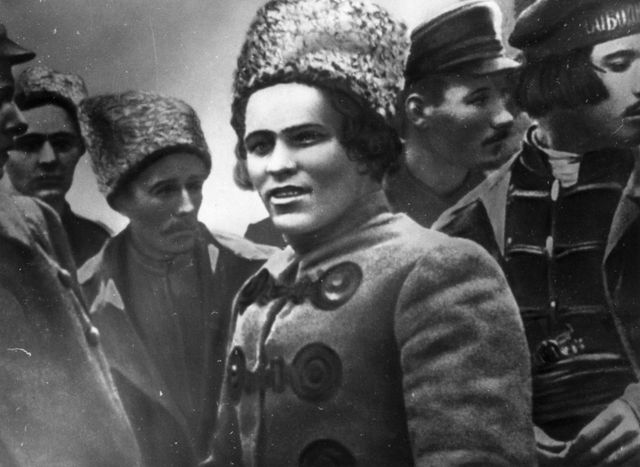 The Anarchists were relatively small and unpredictable. At times supporting the Bolsheviks, at times opposing / Image: public domain
The Anarchists were relatively small and unpredictable. At times supporting the Bolsheviks, at times opposing / Image: public domain
The Anarchists were relatively small and unpredictable. At times supporting the Bolsheviks, at times opposing. In the Spring of 1918 they were disarmed following attempts to stage an uprising within Russia. Initially the Anarchists were principally urban and drawn from the ranks of the intellectual and other petty-bourgeois elements, but in the Ukraine anarchist bands of guerrillas rested on the peasantry. There they eventually coalesced into a large force under Makhno, who fought all-comers, mainly the Germans, but later also the Whites and eventually the Reds.
The Constitutional Democratic Party (Kadets), formed in 1905, was the main bourgeois party, representing capitalist interests. They were broadly liberal, favouring a constitutional monarchy and bourgeois democracy. Following the February Revolution they held five portfolios in the first Provisional Government, including that of Prime Minister (Prince Lvov) and Foreign Minister (Miliukov). Their position steadily eroded as opposition mounted to the Provisional Government’s War Policy. Following the October Revolution they called for the overthrow of the Bolshevik regime and supported counter-revolution. As a consequence they were banned in December 1917.
Consolidating gains, October to December 1917
It is not the task of this article to go into any detail of the seizure of power in October 1917. Leon Trotsky has brilliantly captured this event in his History of the Russian Revolution, John Reed in Ten Days that Shook the World and many other pieces, including recent articles from In Defence of Marxism. The fact of the matter is that the resounding slogan of the Bolshevik Party, "All Power to the Soviets!” received an immediate and overwhelming endorsement from the soldiers and working class in virtually every town and city throughout the Russian Empire.
In fact, in Tallin, Estonia the Soviet seized power two days before the revolution in Petrograd, and on the day of that insurrection, successful transfers of power were also achieved in Minsk, Novorod, Ivanovo-Voznesensk and Tartu. Within eight days of the declaration of a new workers’ state, a further 21 towns and cities had achieved Soviet-led power. Resistance from either the Provisional Government forces or from hostile class forces was, initially, universally weak.
The exception to this was Moscow, where poor planning and preparation by the Bolsheviks and the local Soviet, coupled with a strong resistance from armed Kadets, meant that taking power involved some serious fighting over six days, leading to the loss of some 400 lives. But, by the end of 1917, most of the provincial areas of Russia had declared for Soviet power, usually under the leadership of the Bolsheviks. However, the separate nationalities in the Ukraine, the Baltic States and areas of southern Russia around the Don and in the Caucasus Region proved more resistant to socialist revolution and these were to be acute zones of struggle for years to come.
The first steps of the counter-revolution
While the taking of power proved relatively easy, the counter-revolution soon commenced and various attempts were made to turn back the tide of socialist revolution. In Petrograd, the first, ill-fated attempt to thwart the revolution was undertaken by military cadets, known as Junkers (sons of the bourgeois and middle class), who mounted an armed struggle against the Bolsheviks. After a short conflict, the Red Guards easily disarmed them.
More problematic for the new state was the effort by Kerensky, the former head of the Provisional Government, to wrest back control of the capital by using elements of the Cossacks. Having fled Petrograd in disguise, Kerensky tried to galvanise the Imperial Army from the Northern Front headquarters at Psov. However, the Imperial Army was divided and only General Krasnov agreed to organise an expedition against Petrograd. He set off with 700 Cossacks, hoping others would join him on the way.
These forces, lacking morale and any sizeable infantry support, were defeated by Red Guards, recruited from the Petrograd factories, on the Pulkovo Heights, just a few kilometres from Petrograd. These events occurred only five days after the successful revolution in Petrograd. This marked the end of Kerensky’s direct role in Russian events and he fled to Paris. Krasnov was arrested but later released and went on to participate in the civil war on the side of White Russian counter-revolution.
Laying the foundations for a new socialist order
Following the defeat of these first attempted coups, the new Bolshevik Government was given some breathing space and proceeded to lay down the foundations for a new, socialist system. Lenin drove the pace of change relentlessly. Only a few months prior to the October Revolution, Lenin had completed one of his outstanding works, State and Revolution. This spelled out with great clarity the Marxist view of the state as an instrument of class domination and the need for a successful proletarian revolution to transform the machinery and practice of the state into a vehicle of working-class rule.
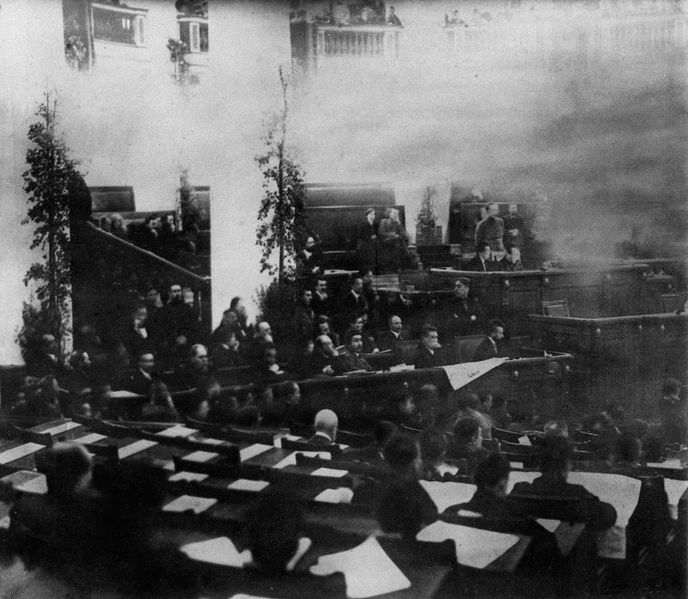 Lenin knew that it was vital to establish the outlines of a new workers’ state immediately after taking power / Image: public domain
Lenin knew that it was vital to establish the outlines of a new workers’ state immediately after taking power / Image: public domain
Lenin knew that it was vital to establish the outlines of a new workers’ state immediately after taking power. Part of his thinking was that the revolution was unlikely to succeed unless and until revolution broke out in one of the advanced capitalist countries. It was therefore imperative to lay down all the markers of a new order so as to establish a guide for the future. Decree after decree was promulgated. By the end of 1917, just over nine weeks after the successful seizure of power, 25 major decrees had been passed, covering such issues as peace, land, the press, civic rights, abolition of estates and titles, right of recall of elected representatives, the judicial system, internal security, economic planning, workers’ control in industry, unemployment insurance, nationalisation of the banks, civil marriage and so on. Many more decrees followed in 1918. In December, the government established the Economic Planning Council to direct production and distribution.
Resistance to revolutionary change: the old classes and the reformist parties
Efforts to establish the new order were carried on amidst the mounting fury of the old order, frantically scrabbling to get a purchase on the situation. Unable, at this stage, to secure any military support against the new government, the old classes resorted to sabotage and non-compliance. Many of the higher-ranking civil servants refused to cooperate with the new powers unless forced at gunpoint.
The first Council of People’s Commissars, established in late October 1917, comprised solely Bolshevik Ministers. The Left-SR Party was invited to take some government posts but refused on the grounds that they wanted a government that included all parties represented in the Soviets. This demand was taken up by the Right-SR Party and the Mensheviks. The Bolsheviks could not agree to this, as some parties were continuing to oppose the revolution and seek the overthrow of the government.
The Mensheviks used their dominant position in the Railway Workers’ Union Executive Committee to pressure the Bolshevik government to accede to the demands for a broad Coalition Government. This was no idle threat, as the railways were key to transport and the movement of arms, goods and other vital necessities. Moreover, they used this muscle to sabotage and disrupt the Bolshevik government’s operations as much as they could. For instance, they refused to allow trains to send troops to assist the revolution in Moscow. They also sought to mobilise other trade unions against the Bolshevik government, many of whom had backward, bureaucratic structures led by Mensheviks.
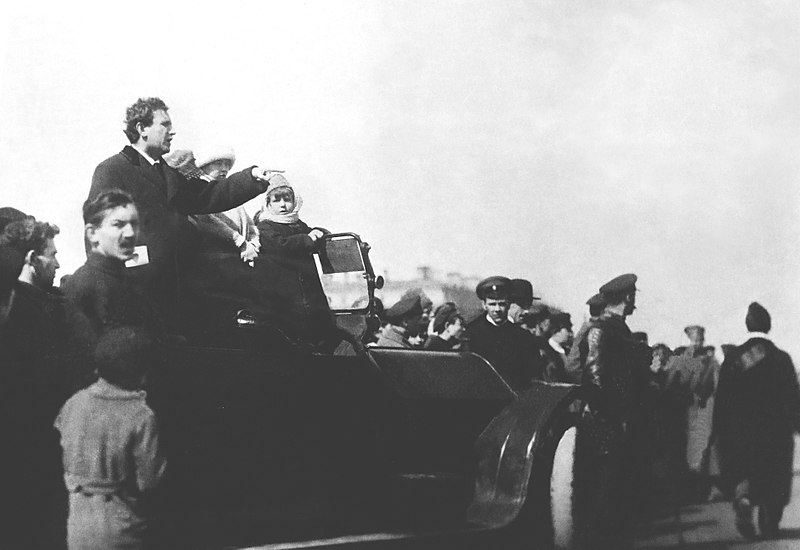 12 Bolshevik members of the cabinet, including Zinoviev (pictured), argued for an all-socialist government in "broad coalition" / Image: public domain
12 Bolshevik members of the cabinet, including Zinoviev (pictured), argued for an all-socialist government in "broad coalition" / Image: public domain
While the majority of Bolshevik leaders rejected the idea of a broad coalition, Zinoviev, Kamenev, Rykov, Nogin and Milyutin – all members of the Bolshevik Central Committee – supported this demand, going so far as to resign from the committee when they lost the vote on 14 November.
Shortly afterwards, five out of the 12 Bolshevik members of the cabinet, including three of the above, resigned their posts and published a manifesto calling for an all-socialist government. Lenin responded robustly. He pointed out that the Left-SRs had been offered places in the government and had declined, and that the purely Bolshevik government had been created and unanimously ratified by the Congress of Soviets. Lenin denounced Zinoviev and Kamenev as deserters and pointed out that they had behaved in a similar “strike-breaking” fashion before the uprising. In the end, the reformist parties had no support among the broad mass of workers, nor in the Soviets, and the idea of a broad coalition collapsed.
While this set the scene for future battles with the Right-SRs and Mensheviks, the Left-SRs, under pressure from a Peasants’ Congress in late November, agreed to participate in the Bolshevik government and fuse with the Soviet Executive Committee. By the end of 1917, the Left-SRs received three places in the cabinet.
The Constituent Assembly and the issue of democracy
Holding elections for a Russian Constituent Assembly had long been a key demand of all socialists, including the Bolsheviks. It was seen as a popular demand to challenge the power of the aristocratic and upper-bourgeois classes entrenched in Dumas (the parliaments and city councils that operated prior to the establishment of the Soviets).
The Provisional Government endorsed the demand after the February Revolution and eventually set the time for elections in late 1917. After the October Revolution, when power had passed to the Soviets, Lenin took the position that the elections should be postponed. He argued that an elected Constituent Assembly represented the highest level of democracy in a bourgeois republic, but once power had been won by the workers on the basis of “all power to the soviets”, this new proletarian democracy represented a higher level still.
While socialists subscribe to democratic processes and indeed demand ever-improved ways of representing the mass of people, the precise form of democracy is not set in stone but must be chosen on the basis that the rights and needs of the exploited are fully and constantly represented. The new workers’ democracy that emerged in revolutionary Russia was not some formal, bureaucratic, once-every-five-years type of system, but a living, breathing, everyday democracy, where delegates were regularly changed in response to new events and new opinions. The right of recall meant that ‘50 percent plus one’ of the electorate could recall their delegate at any time.
Lenin was also against holding Constituent Assembly elections on very practical grounds, arguing that to hold the elections on the basis of out-dated electoral rolls did not reflect the split in the SR Party that had led to effectively two parties – Left-SRs-and Right SRs – and therefore could not accurately reflect political reality at that time. Moreover, he argued there was a need to lower the voting age to 18 and to outlaw counter-revolutionaries who were determined to overthrow the soviet government by force. Without these changes, the election would favour the declining forces of Right-SRs and Kadets. But he was out-voted by the other Bolsheviks, the majority still clinging to a formal notion of democracy.
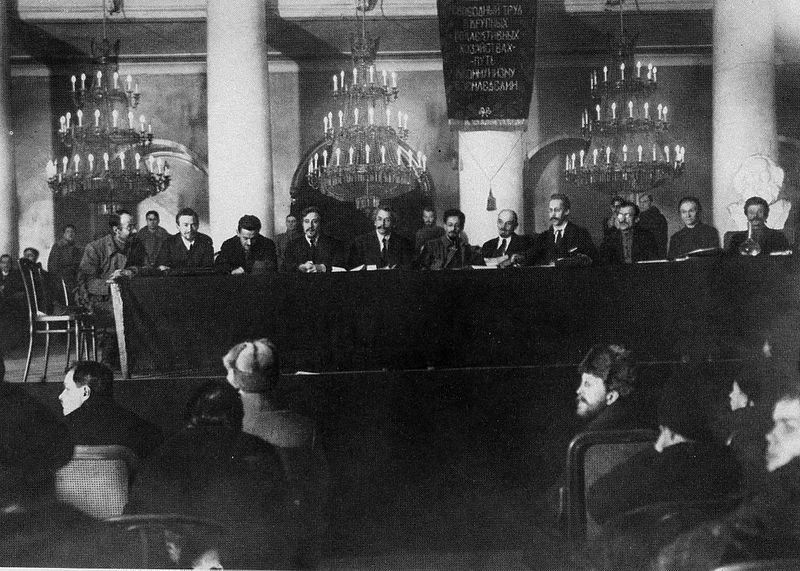 As Lenin had predicted, the Constituent Assembly in the conditions of late 1917 was at best an irrelevance / Image: public domain
As Lenin had predicted, the Constituent Assembly in the conditions of late 1917 was at best an irrelevance / Image: public domain
In the event Lenin was absolutely correct. The elections were held before the revolution had been consolidated. The result was that the SRs were by far the largest party, with the Bolsheviks some way behind in second place. But the result also confirmed two further facts. The first was that the whole country was overwhelmingly left oriented. Moderate socialists, including the SRs, gained 62 percent of the vote; and the Bolsheviks, as revolutionary socialists, around 25 percent. The main bourgeois party, the Kadets, achieved less than 5 percent and the Mensheviks, once so powerful, were reduced to 3.3 percent; much of this vote concentrated in the Caucasus, and Georgia in particular.
While these results seemed to show a powerful position for the SRs, it needs to be borne in mind that the Left-SRs were scarcely on the ballot, due, as Lenin said, to out-dated rolls and candidates. Had the Left-SRs been properly represented there is little doubt the result would have looked very different.
In addition, the Bolsheviks won overwhelmingly in all the urban areas and their immediate periphery, and among many of the key soldier and navy units based in the north. Socialist Revolutionaries who dominated the Constituent Assembly represented the political confusion and indecision of the petty bourgeoisie in the towns and the millions of peasants who were relatively distant from the capital and industrial centres. Anecdotal evidence suggests that many peasants were fully behind Bolshevik policies without realising they were Bolshevik, and also thought Lenin and other Bolshevik leaders were German spies. This latter, insidious lie was widely spread by the bourgeois and Right-SR leaders and their press to confuse peasant voters.
As Lenin had predicted, the Constituent Assembly in the conditions of late 1917 was at best an irrelevance and at worst provided another basis for seeking to overthrow the Bolshevik government. He set out his view with great clarity in an article in Pravda in December 1917. The Theses on the Constituent Assembly hammered home in 19 points the basic arguments Lenin had advanced to the Bolsheviks prior to the elections. He was to take up the issue of bourgeois and proletarian democracy again in a polemic he wrote to counter Kautsky’s revisionist pamphlet, The Dictatorship of the Proletariat, at the end of 1918.
Delegates to the Constituent Assembly began to arrive in the capital in December. Tension was high as the counter-revolution was underway in the Ukarine under General Kaledin and steps were also afoot to start a White Army in the Don region. The Kadets’ support for an armed counter-revolution led by Kaledin led the government to ban the party and the arrest of some of its leaders.
The Constituent Assembly met in January 1918. The Right-SRs were aware of the opposition they faced from the Soviets and the Bolsheviks and tried to prepare a defence, with a Military Organisation and a Committee for the Defence of the Constituent Assembly. They also had a paper (The Grey Overcoat) and the support of two regiments, plus other soldiers recalled from the front. They also had a strong terrorist group. Their main supporters, the peasants, did not seem very concerned about the outcome as they had primarily seen the SR Party and the Constituent Assembly as a means of getting land, which had already by then been promised by the Bolshevik Government through an important decree.
A Right-SR terrorist group had infiltrated the headquarters of the Bolshevik Party and laid plans to kidnap or assassinate its key leaders, Lenin and Trotsky. The leadership called this off when it became apparent that the plan had been leaked. A right-wing demonstration was held on 5 January, attended by the ranks of the city’s petty bourgeois: clerks, intellectuals and so on. They were easily dispersed. It was a sort of botched insurrection. The two regiments that originally supported the SR Party came over to the Bolsheviks.
It was against this tense background that the first and only meeting of the Assembly took place. Sverdlov, on behalf of the Soviet Executive Committee, seized the presiding officer’s bell, declared the meeting open and proceeded to propose a long resolution endorsing all the actions and decrees taken by the Soviet government so far. This was ignored by the Right-SR majority, which proceeded to the election of a president.
Chernov, of the Right-SR Party, achieved 244 votes, as against 153 for Marie Spiridonova, the Left-SR, whom the Bolsheviks supported. Speeches were then made to a background of boos and catcalls from the soldiers in the gallery. When the Assembly refused to discuss Sverdlov’s motion, the Bolshevik’s withdrew. The Assembly rambled on, passing three “laws” on land, a similar one to the Bolsheviks’ on peace (agreeing to the armistice) and finally proclaiming a democratic federative republic. At 5am, the Assembly was ordered to close, as the guards were tired. It dispersed, never to meet again, as the All-Russian Soviet Executive Committee dissolved the Assembly, saying that it served only as a cover for the overthrow of the Soviets. There was popular indifference to this move and the Assembly faded into history.
By the end of 1917, the October Revolution had managed to survive and defeat all the initial forces ranged against it. Moreover, the spirit and mood of the workers and soldiers still coursed with energy. The flames of the revolution, far from sputtering into darkness were burning brightly. But major obstacles to a lasting victory remained. One of the most pressing in the new year of 1918 was the matter of how best to end the war with Germany and the Central Powers.
Taking control of finance and the economy
The Banks were the first important industries to be nationalised.
The state bank refused to pay out money to the new government and the managers went on strike. Eventually, after threatening the officials, the government managed to retrieve 5m roubles. Private banks also refused to assist the new government, leading to their forcible seizure and opening of their vaults. At end of December 1917, all banks were nationalised and fused with the state bank. Withdrawals were limited to no more than 250 roubles per week.
Large houses were taken into public ownership and industrial enterprises that refused to abide by workers’ management were generally taken over. All gold held privately was confiscated by the state. In January, all payments of dividends and dealings in shares were made illegal. In February, all foreign debts were repudiated. Big industry was not immediately nationalised but certain individual concerns of strategic interest were, such as the electricity industry, the Putilov munitions factories and the Belgian Metal Company.
Wages and salaries became the main source of income for all. The government took steps to equalize these. To establish a precedent, the salary of the People’s Commissars was made equal to the average of a skilled worker (500 roubles a month), with an additional 100 roubles per month for each dependant. Lenin, Trotsky and other leading Bolsheviks set a strong example of austere living.
Proletarian organisation
Victor Serge in his book, Year One of the Revolution, mentions that Lenin had urged that “miracles of proletarian organisation must be achieved” in order to overcome the many-headed resistance of the bourgeois class. Only in this way, especially in these early stages, could their resistance and opposition be overcome.
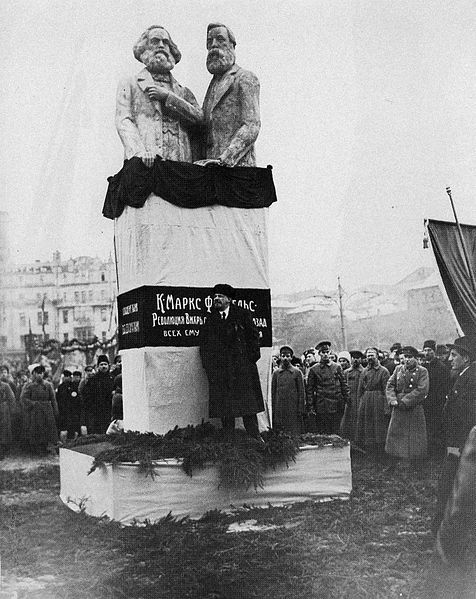 Lenin urged that “miracles of proletarian organisation must be achieved” in order to overcome the many-headed resistance of the bourgeois class / Image: public domain
Lenin urged that “miracles of proletarian organisation must be achieved” in order to overcome the many-headed resistance of the bourgeois class / Image: public domain
In fact, in the months after the revolution, the policy of the Soviet government consisted principally in awakening, stimulating, sometimes guiding, but more usually simply endorsing the initiative of the masses. The Peoples’ Commissars were ordered, by decree, to work in close contact with the mass organisations of working men and women, the sailors and soldiers. Workers took initiatives in many diverse ways. Certain trade unions, for example, undertook to organise sections of industries. In many enterprises, offices as well as factories, employees found that they had to manage their places of work as their superiors had abandoned their positions. This was regularised in a decree legalising the intervention of workers in the management of industry and other workplaces. Workers’ control of industry and offices became widespread.
Some degree of planning and coordination, however, was vital and in December the government established the Supreme Economic Council. This body had the task of coordinating all the activities of local and central organs, which managed and controlled production and distribution. This was the beginning of a centralised planning system that would supplant the rule of the capitalist market.
The press
The Bolsheviks, in common with many socialists, had called for the freedom of the press under the restricted and repressive conditions of the old order. Certainly, it was the early intention of the Soviet government to allow general press freedom. In an early decree on the press, reference was made to the fact that some suppression of the bourgeois press had been undertaken in the immediate period of the revolution. The slogan “freedom of the press” concealed the fact that it was freedom for the propertied class, as they had taken hold of the lion’s share of the press to poison, unhindered, the minds and obscure the consciousness of the masses.
The decree went on to state:
“As soon as the new (socialist) order has been consolidated all administrative pressure on the press will be terminated and it will be granted complete freedom within the bounds of legal responsibility, in keeping with a law that will be broadest and most progressive in this respect.”
Meanwhile the Bolsheviks reserved the right to suppress publications that called for open resistance to the new Government, used slander or distorted facts. In fact, the bourgeois press was operating, relatively freely, as late as May 1918, despite the pressures on the regime. This press remained vicious and slanderous. As conditions deteriorated, press freedoms were curtailed for a number of bourgeois publications and some of the SR publications. This was extended as the civil war intensified and foreign armies intervened in the civil war.
Later in July 1918, the new Constitution of the Soviet Union stated in article 14:
“In order to ensure genuine freedom of expression for the working people, the RSFSR abolishes the dependence of the press on capital, and places at the disposal of the working class and the poor peasantry all the technical and material requisites for the publication of newspaper, pamphlets, books and all other printed matter, and guarantees their unhindered circulation throughout the country.”
State security and the Cheka
As Lenin had spelled out in State and Revolution, the state is at root an instrument of class rule that depends on force to ensure its survival. In the last analysis, this is achieved through having available armed bodies of men, such as the army, police and security forces, to ensure the will of the ruling class. The transfer of one class rule to another is a process of immense struggle that has always involved armed confrontation. The new workers’ state therefore had to have its own bodies of armed men.
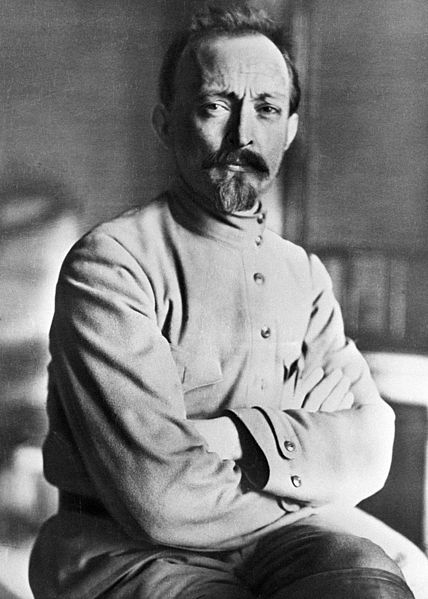 The Bolsheviks established the Extraordinary Commission for Struggle against Sabotage and Counter-Revolution, otherwise known as the Cheka, and placed in charge the Bolshevik leader Dzerzhinsky / Image: public domain
The Bolsheviks established the Extraordinary Commission for Struggle against Sabotage and Counter-Revolution, otherwise known as the Cheka, and placed in charge the Bolshevik leader Dzerzhinsky / Image: public domain
These took time to establish. In the first instance, they took the form of workers militias, which became known as the Red Guards. They acted as both the shock troops of the revolution and the upholders of order within the towns. In terms of internal security, every state deploys its own specialist services. The Bolsheviks established the Extraordinary Commission for Struggle against Sabotage and Counter-Revolution, otherwise known as the Cheka, and placed in charge the Bolshevik leader Dzerzhinsky. In the early stages this organisation proved relatively mild and in the first few months of the revolution there were remarkably few executions or instances of draconian action. However, as the struggle with the reactionary and imperialist forces intensified, the Cheka accrued additional powers and met force with force, achieving a formidable reputation.
Social and cultural changes
Early soviet decrees highlighted the desire of the new order to radically transform social, cultural and religious norms. Central to this was the release of women from their position of legal subservience and oppression in law. In future, only civil weddings were to be recognised by the state and divorce was to be made freely available to either partner. Men and women were given full juridical equality. Children born out of wedlock were to be given the same rights as offspring of marriages. The criminal code that outlawed homosexual activity was abolished, making Russia among the first in the world to do so.
Early in 1918, a law was passed that separated the church from the state. It declared the right of any citizen to profess any religion or none. Religious oaths were abolished, as were church schools. Churches were not allowed to own property and all such property was declared the property of the people, with local and state authorities having the right to hand over buildings of worship to religious societies for free use.
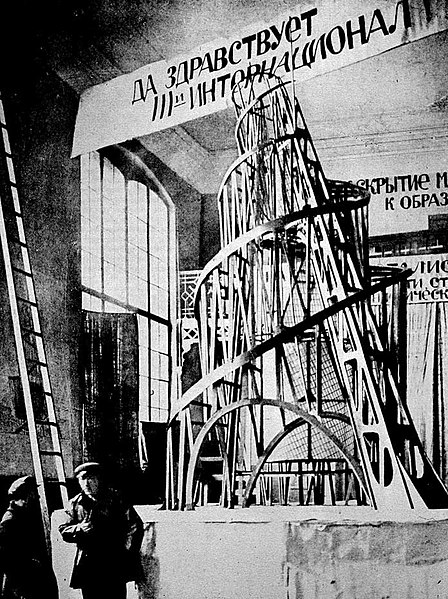 Under Lunacharsky, radical artists were promoted and Russia's rich cultural heritage was made available to the masses / Image: public domain
Under Lunacharsky, radical artists were promoted and Russia's rich cultural heritage was made available to the masses / Image: public domain
In further efforts to align Russia with the modern world, it was agreed to end the use of the Justinian Calendar and, from February 1918, to adopt the Gregorian and West European calendar. This added 13 days to the year and the Revolution of 25 October was subsequently celebrated on 7 November. The Cyrillic script used in printing materials was also simplified.
The orator and somewhat maverick intellectual, the Bolshevik Lunacharsky, was appointed Commissar of Education. His brief also included protecting and advancing the cultural heritage of Russia. He proved a brilliant choice for this office. He was able to cajole and persuade reluctant teachers and academics to continue their teaching and research work under the new regime, despite many of them opposing the new direction. Under his leadership, a major programme to combat illiteracy was embarked upon and he proceeded to reform teaching procedures in a progressive libertarian spirit. New ideas, including Marxism, were introduced into curricula. His approach aroused considerable international interest.
He sought to popularise the arts, taking music, drama, literature and the visual arts to the masses. He was not afraid of the avant-garde and promoted the likes of Chagall and Tatlin to key academies, alongside the work of Eisenstein, the radical filmmaker.
Justice and administration
Justice systems also reflect class rule and so there was an early wholesale change to the Russian justice system. All the general judicial institutions were abolished. Justices of the Peace (JPs) were replaced with local courts represented by a permanent local judge, elected on the basis of direct, democratic suffrage, and two alternate assessors selected by local Soviets. Former JPs and judges were not disbarred from standing for the new posts. Similar changes were made to district and higher courts. Other detailed changes were made to court procedure.
Local government had been largely run by city and council dumas and these were effectively replaced by local and regional soviets. Other local committees and structures also became important, especially the various peasant committees and later the committees of the poor. Local co-operative structures also gained more power after the revolution, although these waned somewhat during the harsh exigencies of 1918 when increased central control was exerted in all aspects of administration.
In July 1918, the All-Russian Soviet agreed a new constitution for “The Russian Socialist Federated Soviet Republic”. This was arranged into the following main articles:
- Declaration of rights of the labouring and exploited people.
- General provisions, which set down a number of key principles.
- Organisation of Soviet power.
- The right to vote.
- The budget.
- The coat of Arms and Flag.
This is an important document as it marked the formal and encoded establishment of a new workers’ state with all its key principles and operating mechanisms. Although, given the acute crises facing Russia at this time, it was not possible to fully implement all its aspects, it nevertheless marked a highpoint of the struggle to overcome the old capitalist state. It was amended and enlarged in 1924 to take account of the creation of the Union of Soviet Socialist Republics and other matters but its key principles remained, until amended by Stalin in 1936.
Peace and war
The Russian Revolution took place during World War One: war and peace were critical issues. The overthrow of the Tsar and the establishment of a democratic government in February 1917 were regarded by the Provisional Government, and by the SR and Menshevik majority in the Petrograd Soviet, as a justification for continuing the support of the war effort in the name of the defence of the revolution.
In practice, this meant defence of the bourgeoisie, since they were the class most empowered by the first Revolution in 1917. The Bolshevik Party insisted that war must end and peace must be achieved on the basis of no annexations or indemnities. Most Bolsheviks supported this. However, there were some in the party, notably Kamenev, who openly espoused the need for continuing the war on the basis of defending the revolution. Lenin opposed this position in his April Theses, recognising that the masses were desperate to see an end to war. He further argued that the position of revolutionary defencism within a bourgeois state was a confidence trick upon the workers and pandering to patriotism and jingoism. From April to October, the Bolsheviks maintained that a Bolshevik revolution, the ending of the war with a democratic peace and proletarian revolution in Europe, were all parts of a single process and in practice inseparable.
Internationalism and revolutionary war
The Bolshevik Party tradition was unreservedly internationalist in outlook. It believed that nationalism was part and parcel of the capitalist system and that wars were an inevitable consequence of that nationalism. They also took seriously the original Marxist international slogan, “workers of the worlds unite, you have nothing to lose but your chains”. In addition, the Bolsheviks were also strongly of the view that a Russian socialist revolution could not be sustained without one or more advanced capitalist countries also becoming socialist and linking up with the Russian proletariat.
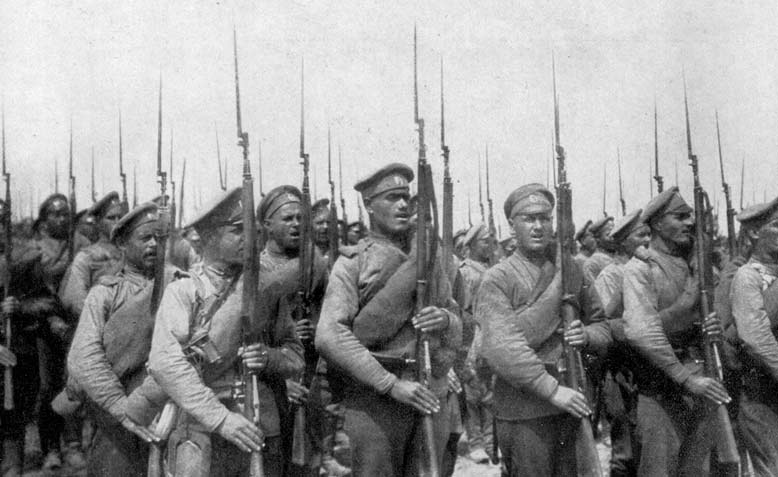 Lenin opposed a 'revolutionary war', but was in a minority within the party leadership / Image: public domain
Lenin opposed a 'revolutionary war', but was in a minority within the party leadership / Image: public domain
Bolsheviks believed that the ending of capitalism and landlordism in Russia would raise the morale of workers and peasants and make them stronger than any opponent. This new class war would rouse the masses internationally. This position was crucial to understanding why the party adopted various positions over the peace negotiations and the issue of revolutionary war. After the establishment of a workers’ and peasants’ state Lenin was not, in principle, against waging a revolutionary war against the imperialist powers but, looking at concrete reality, he understood the masses did not want to fight, even for a workers’ state, at this stage. In any event, the fledgling state had insufficient resources to wage a war of any kind and by December 1917 was faced with civil war. Therefore, Lenin implacably opposed a revolutionary war at this stage. But a majority in the party leadership did not. This set the scene for a prolonged and, in the end, damaging struggle within the Bolshevik Party, which was only finally settled in March 1918.
The peace decree and the armistice with Germany
One of the very first decrees, issued a day after the October Revolution, by the new government was on peace. It called upon all belligerent countries to halt the war immediately on the basis of a just and democratic peace with no annexations or indemnities, and to allow all nations the right of self-determination on a free vote. At the same time, the decree abolished secret diplomacy, calling for open and transparent negotiations, and annulled all secret treaties agreed by the old regime, stating that such secret treaties would be published. Finally, the government called for an immediate armistice.
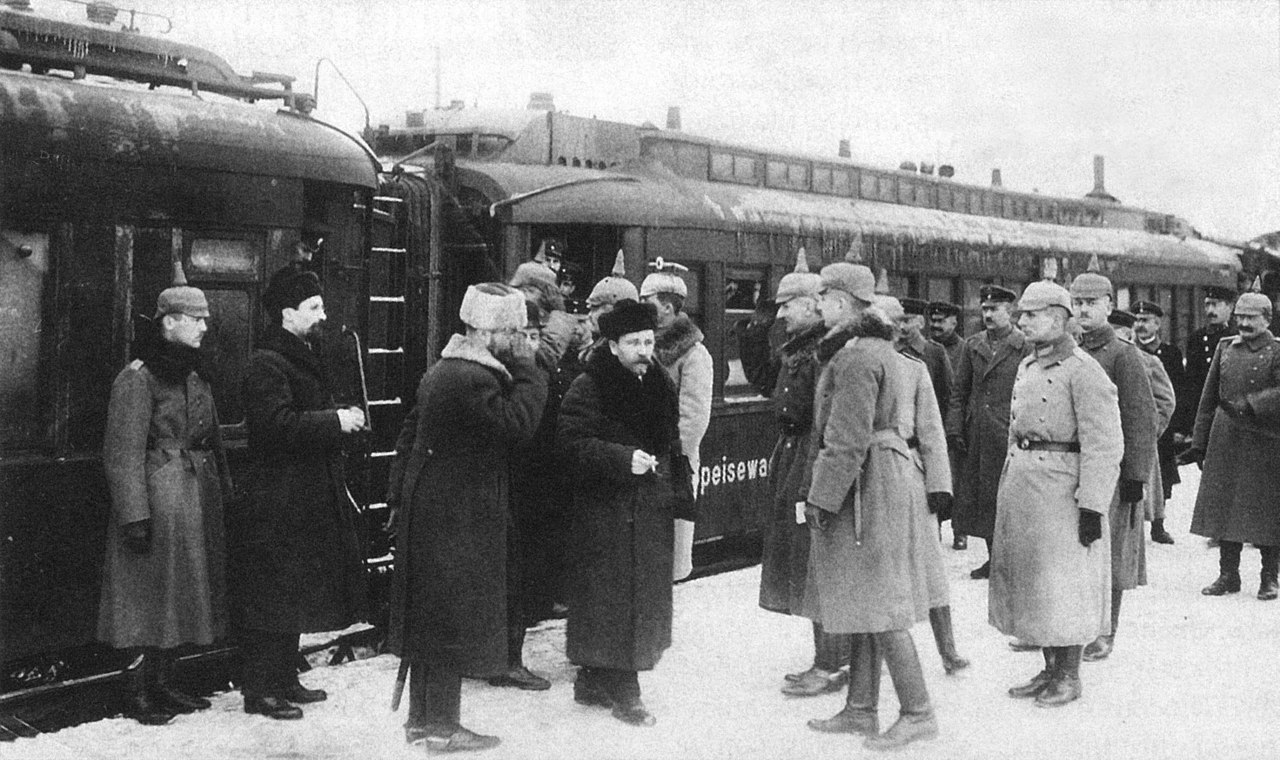 A temporary armistice between Russia, Germany and her allies was agreed on 2 December 1917 / Image: public domain
A temporary armistice between Russia, Germany and her allies was agreed on 2 December 1917 / Image: public domain
After initial negotiations between the Soviet delegation and those of Germany and her allies, an armistice was agreed on 2 December. It allowed 28 days before full peace negotiations took place. It was agreed to maintain current military positions, and further agreed that Germany would not send troops to the western front because of the armistice and would allow a degree of fraternisation between troops.
Trotsky, after some resistance on his part, was appointed Commissar for Foreign Affairs and would eventually lead all negotiations, which were to take place in Brest-Litovsk: a small town on the Russian-Polish border, now in Belarus.
Foreign policy, under Trotsky, comprised largely of appeals to workers and revolutionary groups throughout the world to organise a world revolution. He paid scant attention to the traditional role of a Foreign Secretary, saying, “My job is to publish the treaties, issue some revolutionary proclamations and shut up shop”. Former secret treaties were quickly published, ambassadors recalled and new ones sent out. Money was made available for international revolutionary organisations. Agitational newspapers were published, aimed at foreign workers and prisoners of war. For their part, foreign governments rebuffed Russian attempts to obtain friendly responses and all countries opposed any rapprochement with the Bolsheviks. However, there were contacts between Russia and foreign ambassadors and initially the allies hoped to persuade Russia to continue fighting Germany. When this failed, their opposition to Bolshevik Russia noticeably stepped up.
Negotiations at Brest-Litovsk and Bolshevik splits
Following the armistice agreement, negotiations re-started at Brest-Litovsk, with Joffe initially leading the Russian delegation. These discussions were inconclusive. The Soviet delegation put forward their positions on annexations and the rights of nationalities to enjoy political freedom and ending colonies. The Central Powers (Germany, Austro-Hungary, Turkey and Bulgaria), led effectively by the German General Hoffman, played lip service to these demands as they had no intention of giving up Poland or those Baltic states under their control. Moreover, they now included in their delegation representatives of the Ukrainian Rada (a nationalist-led parliament), weakening the Soviet claim to represent all Russian territories. The Red offensive against the armed nationalists in Ukraine was only just underway.
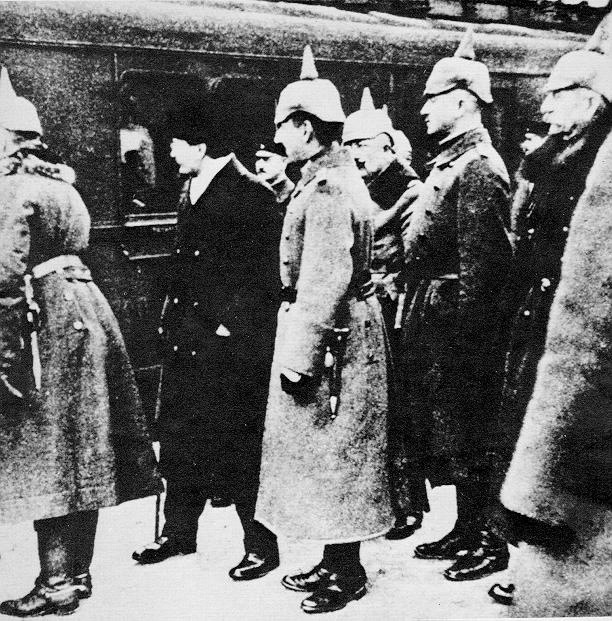 Trotsky took over as leader of the Soviet delegation to the peace negotiations at Brest-Litovsk in 1918 / Image: public domain
Trotsky took over as leader of the Soviet delegation to the peace negotiations at Brest-Litovsk in 1918 / Image: public domain
Trotsky took over as leader of the Soviet delegation in the New Year, and hoping that delaying tactics would work in their favour, used the negotiations as a platform for propaganda. There were definite signs of revolt among workers in Austria and Germany and among their soldiers and sailors. Strikes occurred in Austria in mid-January and later in the month there were serious strikes in Berlin, Hamburg, Danzig and Kiel. Eventually, the Central Powers sought to break the deadlock by stating their demands for the Soviets to cede all territory currently occupied by Germany in the North and to negotiate the southern boundaries with the Ukrainian Rada. Trotsky decided that he now needed to return to Petrograd to discuss with the leadership the best response. There then began a series of debates and votes. In the first meeting, 63 leading Bolsheviks debated the issue of peace. Lenin argued for taking peace at any price to secure the bridgehead of the revolution and wait for better times. Despite Lenin’s prestige, he got only 15 votes. 32 votes, mainly Moscow Bolsheviks led by Bukharin, were for a revolutionary war against Germany and her allies rather than accepting their terms. Trotsky took a third position of neither war nor peace but to continue to delay the proceedings as long as possible in the hope revolution would break out in Germany of Austria and if necessary declare peace unilaterally when pressed. He got 16 votes.
A few days later the Central Committee of the party met and Lenin again called for immediate peace. Only Stalin was clear in his support so Lenin agreed to Trotsky’s delaying position and this passed 12-1. Only two, Bukharin and Dzerzhinsky, supported pursuing a revolutionary war.
Trotsky returned to the negotiations later in January, but after spinning it out as long as possible he made a unilateral declaration to end the war. He then walked out of the talks. Seven days later the German High Command announced it was going to resume hostilities. The Bolshevik unilateral declaration of peace was intended as a signal to all workers and soldiers involved in the war to rise up and oppose their leaders and join the struggle. This did not occur and the Central Powers immediately renewed hostilities. Meeting little resistance, they quickly advanced on all fronts.
Meanwhile, the Bolshevik Central Committee was in almost continuous session. Lenin again called for seeking terms with the Germans, but got only 4 votes against 6, with Trotsky voting against. Lenin then posed the question: what if the German army advanced and there was no revolution in Germany and Austria? By 6-1, with 4 abstentions (Trotsky went over to Lenin) it was agreed that, in that event, peace should be made. But the Germans were already advancing. The issue was debated the following day. Despite some movements, the vote for Trotsky’s hesitation again carried 6-5. But by evening it was clear the German advance was strong and Russia was threatened. At this point Trotsky went over to Lenin and the Central Committee agreed to ask for peace negotiations by 7-5. Other party and Soviet bodies rapidly ratified this decision, although not without division, and a telegram was sent off agreeing to a renewal of the peace negotiations.
The final Brest-Litovsk Treaty and its ratification
However, Germany was in no hurry to accept and took full advantage of its position, advancing deep into the Ukraine and other areas. Eventually, the Germans came up with new, much harsher terms than before: Soviet withdrawal from Ukraine, Lithuania, Estonia and Finland and the ceding of territory to Turkey in the south. The treaty also demanded Soviet recognition of the Ukrainian Nationalist Government or Rada. The implications of the Treaty for the economy of Soviet Russia were immense. They lost some of the most productive areas of Russia, especially in the Ukraine with its large assets in coal, industry and agriculture. In all they lost 40 percent of industrial capacity, 45 percent of fuel, 90 percent of sugar, 70 percent of the metal industry and 55 percent of wheat potential. The demand to withdraw the Red Guards from Finland led to a German-backed counter-revolution of considerable ferocity.
So harsh were these terms that many leading Bolsheviks, especially in the Moscow Region, again resisted acceptance and ratification. There followed another heated debate in the Bolshevik Central Committee. Lenin moved acceptance, this time saying he would resign if he didn’t gain the vote. Trotsky opposed but, in the end, abstained, as did Dzerzhinsky, Joffe, and Krestinsky, giving Lenin a 7-4 majority. In early March, the Soviet Government signed the new terms of Brest-Litovsk. Full internal ratification had to go through various bodies and the debates raged on. At the Seventh Bolshevik Party Congress in March 1918, Trotsky again reiterated his opposition to accepting such harsh terms but declared he would not vote against Lenin. This was then carried by 28 votes to 9. At the all-Russian Central Executive Committee, after a speech by Lenin it was carried 116 votes to 84. On 16 March, the All Russian Congress of Soviets, after two days of stormy debate, ratified the government’s decision by 784-262.
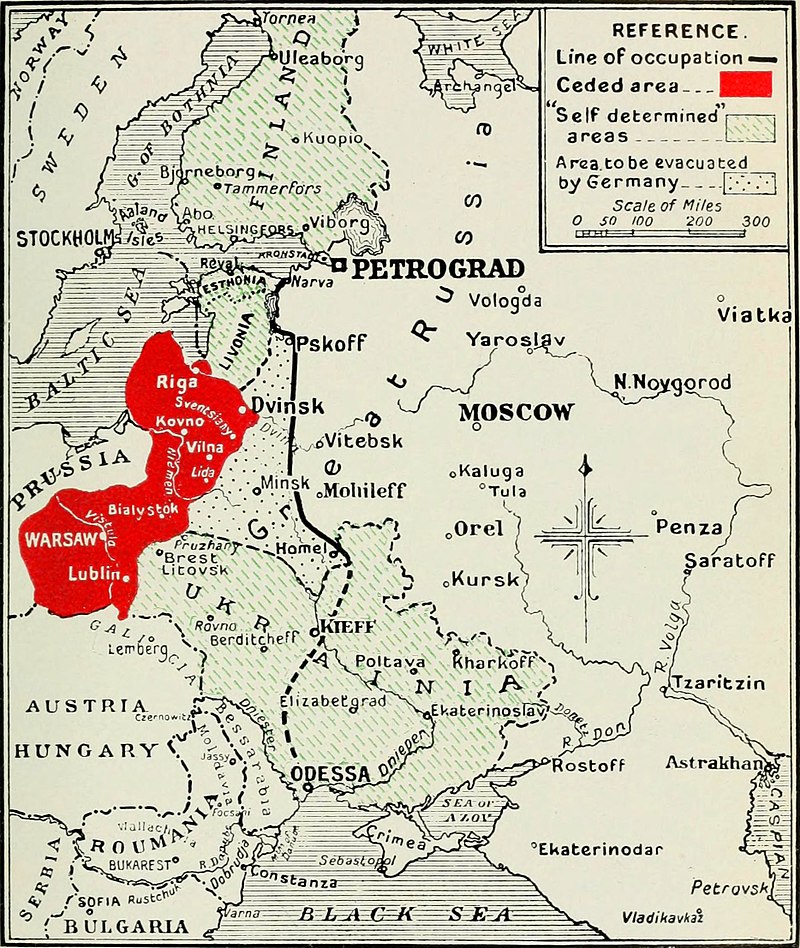 The Germans demanded Soviet withdrawal from Ukraine, Lithuania, Estonia and Finland, ceding of territory to Turkey in the south and recognition of the Ukrainian Nationalist Government or Rada / Image: public domain
The Germans demanded Soviet withdrawal from Ukraine, Lithuania, Estonia and Finland, ceding of territory to Turkey in the south and recognition of the Ukrainian Nationalist Government or Rada / Image: public domain
These details are recounted to illustrate the tradition of debate and internal democracy within the Bolshevik Party and Soviet Russia at this time. This tradition, although necessarily curbed in the acute conditions of Civil War later in 1918, nevertheless remained at the heart of the Bolshevik Party as long as Lenin and Trotsky remained at the helm. It is instructive, in view of the later cult of the personality around Stalin, that Lenin, despite his immense standing in the party and among the workers, was consistently opposed by many leading comrades throughout this process. When he was defeated he accepted it and fought on with unflinching argument in meetings and in writing.
In fact, a notable feature of Lenin throughout is that at every stage and moment of the Revolution he was not only driving the process in practice, with attention to every detail, but also writing articles, resolutions and even longer works. It is true that, in the final stages of the debates on Brest-Litovsk, Lenin threatened to resign if his views were not accepted, but this was after months of exhaustive debate and at a critical moment for the survival of the revolution. Lenin always considered it vital, at this stage of world developments, to keep the core of the revolution secure.
The left wing of the party, around Bukharin, openly stated that they were prepared for a split in the party and were willing to sacrifice the revolution on the altar of an international revolutionary war. Lenin considered this absurd posturing and wrote a biting critique in February 1918, called “Strange and Monstrous.” In this piece Lenin shows how the process of debate within the party was carried out. He vigorously defends the left-wing’s right to express its view:
“It is quite natural that comrades who sharply disagree with the Central Committee over the question of a separate peace should sharply condemn the Central Committee and express their conviction that a split is inevitable. All that is the most legitimate right of party members, which is quite understandable.”
But, he did not fail to condemn their reasoning as “strange and monstrous”, nor hesitate to call them out for revolutionary phrasemaking. Immediately after the conclusion of this drawn out process of Peace he wrote a substantial text on the broader issues it raised and called it, Left-Wing Childishness and Petty-Bourgeois Mentality. He was to return to this theme two years later in 1920 when he wrote Left-Wing Communism: An Infantile Disorder.
Soviet foreign policy in 1918
Before returning to the immediate issues at home it is worth noting another issue that split the Bolsheviks at this stage and it again illustrates the division between the realists and what Lenin called a petty-bourgeois mentality. This occurred over the approach the Soviet Government should take in confronting the capitalist powers.
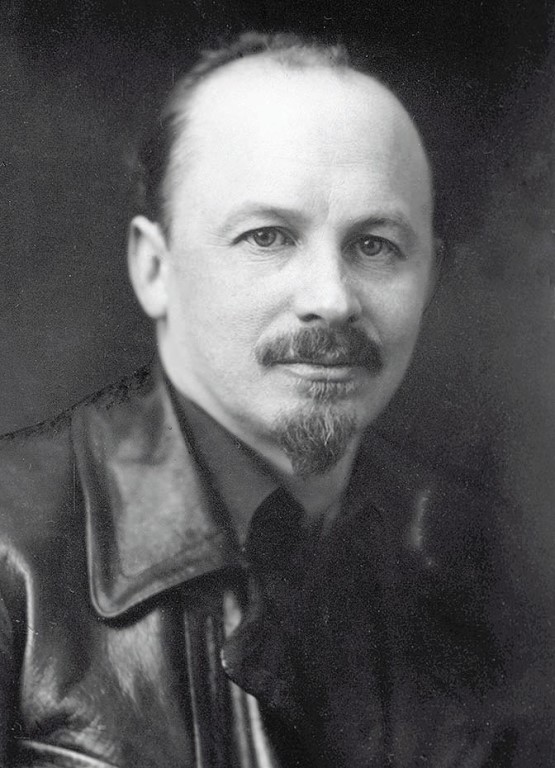 The left wing around Bukharin, stated that they were prepared for a split in the party over the question of revolutionary war / Image: public domain
The left wing around Bukharin, stated that they were prepared for a split in the party over the question of revolutionary war / Image: public domain
The notion widely held at one time, that a workers’ government would have no truck with any capitalist power, proved untenable and unrealistic. The capitalist states were not a uniform bloc and divisions could be exploited. The leftists, led by Bukharin, refused to contemplate any deals with the capitalists. Lenin and Trotsky tended to operate on the pragmatic and realistic side, although, as we have seen, Trotsky sometimes took longer to reach the same conclusions as Lenin. Occasionally, it was the other way around, with Lenin acknowledging that Trotsky had been correct. In the Central Committee in February 1918, Trotsky argued in favour of accepting arms from any country, even capitalist ones, on the one condition that no political obligations were given to these countries in return. This was hotly debated and only carried 6-5 with Lenin not attending but supporting the proposal. In the end, this proposal was without effect because the vague offers of support from USA, Britain and France were predicated on keeping Russia in the war so as to keep Germany pinned down in the east. Once the Brest-Litovsk Treaty was finally signed the other imperialist powers declined Russia any assistance.
In the wake of the Brest-Litovsk Treaty a dual, inter-meshed foreign policy emerged: to promote world socialist revolution and defend the national security of the Soviet Republic. This would last as a consistent and integrated approach throughout the civil war and until the fight against the aggression of the allied powers finally ended in early 1921. Stalin later tried to portray a split between Lenin and Trotsky over the issue of world revolution or socialism in one country. In fact, this is entirely false and distorts the real split, which was between Lenin and the left communists that included Bukharin, Radek and Uritsky.
Lenin, like Trotsky, remained a powerful advocate of world revolution and indeed frequently said that it was the only hope for the long-term success of the Russian Revolution. Lenin said that if necessary he would be in favour of sacrificing the Russian Revolution for a German Revolution, if it occurred, which would be on a much higher level and would hasten world revolution. The difference between Lenin and Trotsky was essentially one of balance. Trotsky was slower than Lenin to realise that the German Revolution would take time to mature, over-estimating the prospects for revolution.
Early struggles on the periphery
The general headquarters of the Russian Army, a veritable citadel in a time of all-out war, was situated away from Moscow and Petrograd. Here the Bolsheviks were weak. The soldiers’ Committee of the Armies, which had been elected at the beginning of the February revolution, was controlled by the SRs and had a cosy relationship with the generals. Six days after the October Revolution, they decided to oppose the Bolsheviks and march on Petrograd. But the mood of the soldiers, who welcomed the revolution, prevented this. When Lenin then called on the soldiers to elect new delegates and organise for an armistice with Germany, the old army establishment was doomed. These elections were held on 18 November. Following these elections, General Dukhonin, the supreme army head, who had defied the Bolshevik Government’s orders, was arrested and executed.
From October to March, the strong tide in favour of the Bolshevik-led Soviet Government had swept most urban and working-class areas of Russia. Even in the strongly nationalist areas of the Ukraine, parts of the Caucasus and the Don region, Red forces had been triumphant. Local soviets had sprung up everywhere. Most of the troops were with the Bolsheviks and the peasantry were broadly supportive as they saw their land needs being addressed. But from that point on the situation for the government became more and more difficult. The ending of the First World War proved a key factor in the west, as German troops occupied so much of the land that was highly productive for all parts of the economy. The Germans and their allies were keen to weaken Russia as far as possible and also to undermine Bolshevism by arming and encouraging nationalists and elements of the old order in Russia, principally the old Tsarist generals and officers, so that they could mount an effective counter-revolution. This, in effect, was the start of three years of brutal civil war.
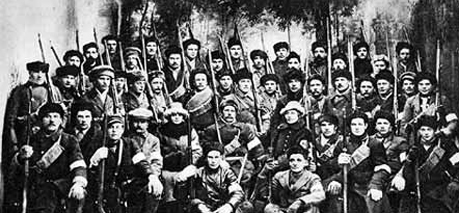 Anti-Bolshevik, White forces in Russia, 1918 / Image: public domain
Anti-Bolshevik, White forces in Russia, 1918 / Image: public domain
A number of generals and officers of the Imperial Army fled south to the Ukraine, where the Government was nationalistic and anti-Bolshevik. An Army of Volunteers, as the first White force was called, led by General Kornilov, gathered in the south, with more officers than men. Ukrainian nationalism, infused with certain elements of socialism, attempted a form of self-government under the old parliament, called the Rada. Eventually, struggles broke out between Bolshevik supporters in Kiev and the nationalists; the Reds took Kiev in January. Ukraine fell largely under Bolshevik control by February 1918.
After November there was a general strike in Finland. This was largely victorious but there was no revolutionary workers’ party prepared to take power. So, the workers took matters into their own hands and took power in Helsinki, driving out the bourgeois government. Still, the social democrat leaders failed to drive through a revolution and opted for radical but piecemeal change. The Russian Government passed a decree giving independence to Finland at the end of 1917. Momentum gathered in 1918 and by February a new constitution was established providing for an elected assembly every three years along with other highly advanced features.
The Finnish social democracy attempted the highest ever form of bourgeois democracy. But, in the circumstances, it was utopian and met with fierce armed reaction. The bourgeois launched a White terror, using a battalion of Finns in the German army. Red Guards and soviet supporters flocked to support the working class. Soviet forces had to withdraw under the terms of the Brest Litovsk Treaty. Vicious fighting then led to extreme white terror and the defeat of the Red forces. Up to a quarter of the proletariat were subsequently killed and murdered (100,000).
The Caucasus area was complex with many nationalities and conditions. This proved a difficult area for the pro-Bolshevik, revolutionary Red forces who were initially defeated by a combination of so-called socialist Georgians and reactionary Turks and Tartars.
In the Don region, another complex war occurred, involving several old imperial generals, complicated by divisions within the Cossacks population. The Cossack cavalry had traditionally been used by the Tsarist regime as a force for reaction. When the October Revolution, occurred the Don Cossack Council declared independence. General Kaledin welcomed former officers and some soldiers from the old imperial army and thus began the formation of a White army that was to play a lasting role in the ensuing civil war.
In December 1917, the Soviet government sent a Red Guard force to assert Soviet control. At this stage, the White forces were ill-equipped, poorly organised and unable to resist the Red forces. As a result, the Don Cossack Council agreed to yield to the Soviet forces, causing General Kaledin to commit suicide. The tide turned in May 1918 due to the German invasion in the west and the growth of the White forces under Generals Kornilov and Alekseev. The Cossack leadership rebelled against the Soviet administration and, with the improved White forces, armed and supplied by the French and British, were able to defeat most Red forces and resume control over large areas. In the process, there were many massacres and atrocities against Bolsheviks and the working class generally.
In Siberia and in the Central Asia regions Bolsheviks also achieved early success in the main centres, only to suffer reversals at a later stage.
The White Forces
The White movement and its armies were so-called because the colour white was associated with the Tsar. They represented the old defeated classes of the monarchy and the bourgeoisie. The movement, as such, did not have a strong social base. It drew in various elements dissatisfied with the Bolshevik regime, usually reactionary nationalist elements. Few wanted to see the Tsar restored, except the leaders and especially the army leaders, who became, in effect, petty dictators.
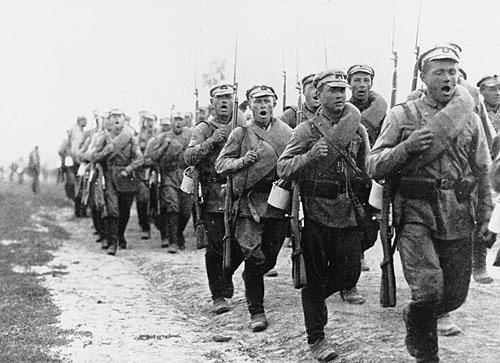 The Red Army, under Trotsky, achieved a strong, centralised leadership and had a clear purpose of defending the revolution / Image: public domain
The Red Army, under Trotsky, achieved a strong, centralised leadership and had a clear purpose of defending the revolution / Image: public domain
In general, the White leadership was against separate national states and desired a return to a united empire. There was also a strong current of antisemitism within the White armies. Western sponsors expressed dismay at this, especially as the Bolsheviks had prohibited antisemitism and appeared more progressive. Winston Churchill personally warned General Denikin, whose forces effected pogroms against the Jews, that “my task in winning support in Parliament for the Russian Nationalist cause will be infinitely harder if well-authenticated complaints continue to be received from Jews in the zone of the Volunteer Armies”.
One of the abiding weaknesses of the White forces was their lack of unity. The leaders squabbled and there were many who joined the umbrella of the Whites simply because they opposed the Bolsheviks, rather than having a united vision of what they wanted. Ultimately, this played into the hands of the Red Army, which, under Trotsky's command, achieved a strong, centralised leadership, and, of course, always with the clear purpose of defending the revolution.
Backs against the wall
Whilst the broad mass of the working class continued to give their support to the Bolshevik Party, activists within the party were often split on crucial issues. The issue of whether or not to wage a revolutionary war against Germany and its forces of occupation proved one of the more divisive questions that very nearly led to a complete split in the party.
The division started in February, when the Moscow Region Committee took a ‘left’ position and called for non-acceptance of the Brest-Litovsk Treaty and the heroic sacrifice of the Russian proletariat on the altar of internationalism. Lenin provided a powerful critique of this position, calling them “Communists of misfortune” and “talking despair”. By March this tendency had crystallised into an organised faction and were called Left Communists. They were led by Bukharin with the support of Radek and Uritsky, among others, and published a paper called the Kommunist. Several members of the faction were elected to the Central Committee but they refused to serve.
The two tendencies faced off at the 7th Party Congress in March 1918. Lenin’s position on peace was supported by Zinoviev, Smilga and Sverdlov. Trotsky also sided with Lenin but urged war in Ukraine against the German occupiers. Lenin, whilst not against such a move, argued for space and time to build up forces. It was at this Congress that the name Communist Party (Bolshevik) was adopted and it was agreed to review the Programme of the Party.
In April 1918 Lenin published The International Position of the Russian Soviet Republic and the Fundamental Tasks of the Socialist Revolution. In it, Lenin argued that at that time a brief respite existed when all efforts had to be made to tackle the issue of organising the new Soviet system in an administrative sense. This required honest accounting, no stealing and strict labour discipline. The most class-conscious workers must lead the drive to implement these slogans among the masses.
The aim was to establish a productive and efficient system that began to address the accumulated chaos of the war years and restore some order and benefits for people weary and close to despair. In the conclusion Lenin stated the situation clearly:
“An extraordinarily difficult, complex and dangerous situation in international affairs; the necessity of manoeuvring and retreating; a period of waiting for new outbreaks of the revolution which is maturing in the west at a painfully slow pace; within the country a period of slow construction and ruthless ‘tightening-up’, of prolonged and persistent struggle waged by stern, proletarian discipline against the menacing element of petty-bourgeois laxity and anarchy: these in brief are the distinguishing features of the special stage of the socialist revolution in which we are now living”.
Trotsky struck the same note in March when he gave a speech to a Party Conference. He emphasised the need for “labour, discipline and order” and urged that specialists be given a role in managing industry. In the same vein, he justified abandoning the principle of the election of officers in the Red Army, arguing that it was now a proletarian army and the need to challenge the Imperial officers through elections no longer applied. They needed the best, most-skilled and experienced to fill officer roles. The Left Communists published a critical response in their paper, Kommunist, which opposed the army reforms and at the same time called for the faster expropriation of capital and the cooperative organisation of production and distribution based on full workers’ control and management. Lenin replied in a series of articles in Pravda in May 1918, called Left Infantilism and the Petty-Bourgeois Mentality.
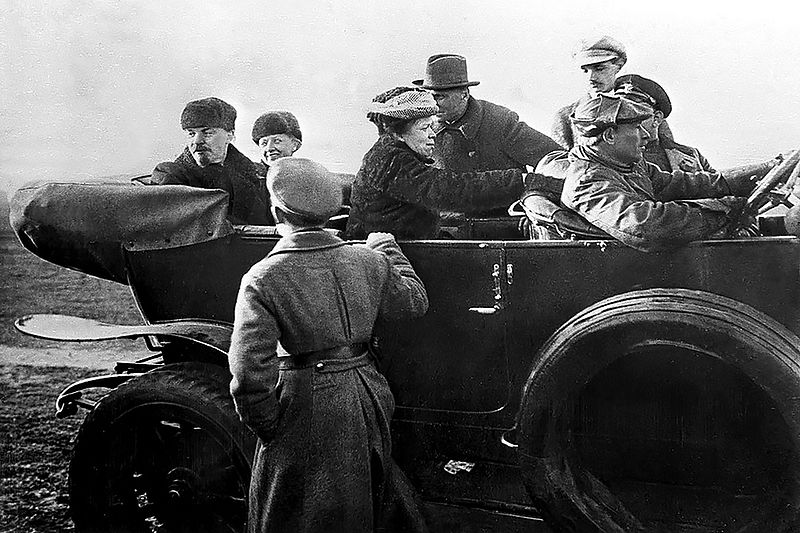 Lenin replied to the Left Communists in a series of articles in Pravda in May 1918 called 'Left Infantilism and the Petty-Bourgeois Mentality' / Image: public domain
Lenin replied to the Left Communists in a series of articles in Pravda in May 1918 called 'Left Infantilism and the Petty-Bourgeois Mentality' / Image: public domain
The major debates that ensued through the Spring and Summer within the Party are important and instructive but require a more detailed analysis than can be offered here. Suffice it to say that, having lost the vote at the March Congress the Left Communists then lost their positions on the Supreme Council of National Economy and shortly afterward lost their control of the Moscow and Urals regional organisations. When the Soviet government, under different conditions, nationalised all large industrial enterprises in late June, many Left Communists considered this to be a correct economic policy and shifted their support back to Lenin. By the end of the summer, the Left Communists no longer existed as a distinct opposition group.
Political opposition outside Bolshevism
Efforts to overthrow the Bolshevik Government at home had not disappeared. In fact, in the harsh conditions of spring and summer 1918, when famine stalked the land, their efforts grew. Although the bourgeois parties, such as the Cadets and the Octobrists, had little support, there was lots of intrigue and rumour with foreign powers seeking to find suitable organisations to back. Several right-wing organisations and conspiracies were attempted. The Right or Moscow Centre (businessmen, landowners and conservative and liberal politicians) had a military department but was weak and disorganised. The National Centre, which split off from the Right Centre in June 1918, was a rallying point for the Cadet Party. Overall there was no real drive or unity between any of them and they were easily and, relatively leniently, dealt with by the Cheka.
The petty-bourgeois parties, which included the SRs of Left and Right, the Anarchists and the Mensheviks, did have a potential mass base given the weight of the peasantry in the country, and could have posed a serious problem for the Bolsheviks. But, as Lenin pointed out, the petty-bourgeois parties, like the class they represented, wavered and vacillated at every turn, becoming revolutionary one moment and, when things got difficult, siding with the bourgeoisie, or turning to terrorism. Not surprisingly the mass of peasants was largely uninterested.
The Right SR Party, lacking their base in the Constituent Assembly, had nowhere to go except an alliance with the White forces. This they did in a more and more overt fashion. In the spring of 1918 Savinkov, a veteran SR conspirator, helped to establish the Union for the Defence of the Motherland and Freedom. It claimed to have 5,500 members, but they were scattered all over the country. Its objective was to overthrow Soviet power and establish a military dictatorship. They had financial support from several imperial powers, notably France. Several leading members were arrested in May 1918 and its planned actions were foiled. Savinkov and others remained at large and tried to organise armed uprisings in several towns in July 1918, but these were easily overcome and the organisation faded away. Savinkov and other Right SRs re-emerged in the short-lived Samara Government on the Volga (described in more detail below).
The All-Russian Soviet Executive had representatives of all parties that participated in local and regional Soviets. Thus it had left Mensheviks, Left SRs and others. But in June, as the struggle for survival became paramount it was agreed to expel all those parties who were instigating civil war against the Soviets. This was both logical and necessary. This removed Right SRs and Mensheviks and left only Left SRs and Bolsheviks.
The terrorist wing of the Right SR Party, the so-called “Battle Organisation”, had one last throw of the dice at the end of August 1918 when they sought to assassinate a number of leaders, including Lenin and Trotsky. Lenin was shot by Fanny Kaplan and was lucky not to have been killed. Although struck in his shoulder and neck he survived and recovered after the operation and a short convalescence. The plot to kill Trotsky failed when he altered his planned route to Kazan at the last moment. Uritsky, the President of the Petrograd Cheka, was less lucky and was killed.
The Left SR Party ostensibly represented the poor peasantry but in practice tended to base themselves on the middle peasantry. They had a significant position in the Soviets. They left the government over the Brest-Litovsk Treaty in March 1918 but continued to offer critical support to the Bolsheviks for a period.
At the Fifth All-Russian Congress of Soviets in early July 1918, the Left SRs had 353 delegates out of 1,164. Nothing illustrates the vacillating and intemperate nature of petty-bourgeois revolutionaries better than the debates at this Congress, where the Left SRs hysterically attacked the Bolsheviks for their determination to maintain discipline in the Red Army on the border with Ukraine. The Left SRs had been agitating amongst these units, inciting them to join guerrilla bands inside the Ukraine and attack the German occupiers. Calling for discipline, Trotsky asked for approval of an order to shoot those responsible for fomenting such division and adventurism. The Left SRs erupted with fury but were soundly defeated in the vote.
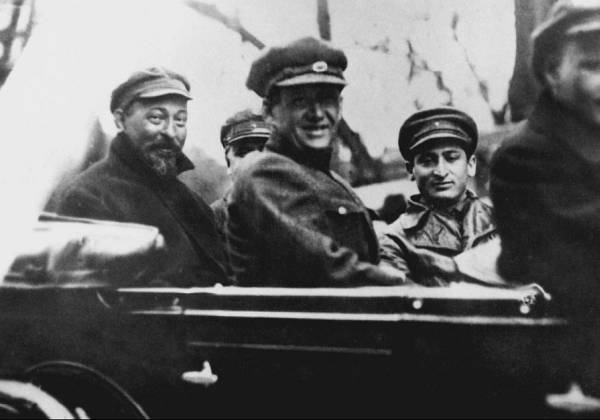 When Dzerzhinsky, the Cheka leader, confronted the Left SR Committee in Moscow they arrested him and proceeded to use Cheka forces they controlled to occupy key parts of Moscow. With this act, they effectively 'committed suicide' / Image: public domain
When Dzerzhinsky, the Cheka leader, confronted the Left SR Committee in Moscow they arrested him and proceeded to use Cheka forces they controlled to occupy key parts of Moscow. With this act, they effectively 'committed suicide' / Image: public domain
Later, one of their leaders, Maria Spiridonova, made wild accusations against the Bolsheviks and was calmly rebutted by Lenin. Then news arrived at the Congress that Left SR agents had infiltrated the German Ukraine headquarters and assassinated the German ambassador, Count Mirbach. When Dzerzhinsky, the Cheka leader, confronted the Left SR Committee in Moscow they arrested him and proceeded to use Cheka forces they controlled to occupy key parts of Moscow. In the event, they lacked any popular support and the rebellion was put down in a day. Arrests and some executions followed. As Victor Serge says in Year One of the Revolution, “The Left SR Party had committed suicide”.
Anarchist groups were also present in most towns, but many were self-styled and close to banditry. They had gained some support, generally fighting with the Reds in November. They had their own Black General Staff, and were armed. In the period after March, they assumed a more anti-Bolshevik position and moved to violence. However, disarming them proved easy as they had little broad support. Hundreds were arrested but most of those who were genuine anarchists by conviction were released and allowed to operate more or less freely with their organisations, press and clubs. The anarchist movement in the Ukraine led by Makhno is a different story and is dealt with in a later installment.
After the October Revolution, the Menshevik Party became a shadow of its former self and had split into left and right factions. The weakness of the Mensheviks is revealed in the elections for the Constituent Assembly, when they only managed 3 percent of the vote. However, they were relatively strong in the Caucusus region, where they had taken a strongly pro-nationalist line. They had a majority position in Georgia and from May 1918 led an independent government, under the general permission of the Germans, known as the Democratic Republic of Georgia. Nationally, most Mensheviks who had not joined the Bolsheviks increasingly sided with counter-revolutionaries. Martov and the left faction continued to operate in a more principled fashion but became increasingly hostile to the Bolsheviks.
The end of the Romanovs
A brief mention should be made of the denouement of the Tsar and his family, the Romanovs, which occurred in the summer of 1918.
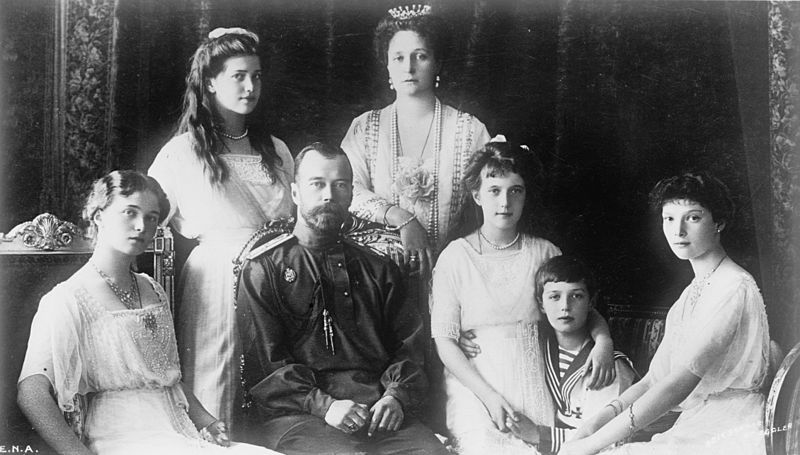 In July 1918, Ekaterinburg (where the Romanovs were being held) was virtually encircled by White forces and the Urals Soviet decided to execute the Tsar and his family / Image: public domain
In July 1918, Ekaterinburg (where the Romanovs were being held) was virtually encircled by White forces and the Urals Soviet decided to execute the Tsar and his family / Image: public domain
After February 1917, the Romanovs had been held in comparative ease at the imperial palace at Tsarskoe Syelo. But after the July 1917 days of upheaval, the Provisional Government decided to place the family deeper into Russia in the remote Siberian town of Tobolsk. After the October Revolution, the question of what to do with the Tsar and his family became a more burning topic, as they clearly provided a rallying call for the counter-revolutionary forces. After a White Army approached the Tobolsk in April 1918, the Bolsheviks moved the imperial family west to Ekaterinburg in the Urals. In July, Ekaterinburg was virtually encircled by White forces and the Urals Soviet decided to execute the family.
The economic crisis and feeding the urban population
Prior to Brest-Litovsk and the German occupation of Ukraine, the Russian economy was already in a poor state. The effects of years of war and then the upheaval of revolution meant that production and distribution were massively disrupted. Moreover, as in all belligerent countries, the economy had become heavily oriented to the needs of war and the millions of troops that were required. The loss of the valuable economic areas of Ukraine, Caucasus and later the Don region provoked a major crisis after March 1918.
The primary and immediate problem was the need to obtain sufficient grain to feed the people, especially in the urban areas. The harvest was still to come. People were hungry and desperate. Riots and uprisings over lack of bread were not uncommon. Lenin said at this time, “To get bread, that is the basis of socialism today.” This called for desperate measures. The first of these was the creation of the Food Commissariat with sweeping powers (decree of 27 May) to supply the population with objects of primary necessity. The Food Commissar was Tsurupa, and among his powers was the ability to remove local commissars, override local soviets and in certain circumstances institute court proceedings against disobedient representatives of local soviets.
What ensued was a battle between the consuming, needy provinces and the producing provinces that held surpluses of food, often hoarded. Special armed detachments, recruited predominantly from Bolshevik-supporting factories, were attached to local food committees in the producing districts. Wealthy peasants, known as kulaks, were those mainly responsible for hoarding grain and other food resources. On 11 June, the Soviet regime set up Committees of the Poor all over the country. These committees were empowered to distribute grain, products of prime necessity and agricultural machines and to cooperate with local food brigades in taking surplus grain away from kulaks and other richer peasants. Incentives were offered to the poorer peasants to participate in this process. There was provision to exclude from any expropriation the slightly better-off peasants who possessed just a few livestock and hired one or two labourers, as long as they were basically self-sufficient. This was reinforced in August 1918 when a letter was circulated to try to prevent the alienation of middle peasants.
Certainly, there were many excesses and ferocious battles. 26 peasant uprisings were recorded in July, 47 in August, and 26 in September. In some cases, old scores were settled. In some instances, bandits and thieves joined the committees; and in some, genuine local communists were driven out of important and potentially lucrative posts such as the collection of local taxes. But, the tactic of splitting the villages on class lines was broadly successful. In regions where there was much poverty among the peasants the actions against kulaks and others were more severe. In areas closer to the big cities, there was greater control and order.
At their height, the Committees of the Poor numbered tens of thousands and as a policy they prevented a complete breakdown of society. There was famine and great hunger but it would have been much worse without such drastic, organised intervention. By November 1918, the crisis was passing and the Committees of the Poor were dissolved and there were new elections for local soviets, which included the best representatives of the old Committees. The two bodies were in effect fused. On 8 November 1918 Lenin declared Soviet policy in the village would be:
“To reach an agreement with the middle-class peasantry, not relaxing for a moment the struggle against the kulak and relying firmly only on the poor.”
The impact of the continuing food shortages can be seen in the major loss of population suffered by the towns and cities where people moved to the countryside to find food. Petrograd’s population, for example, declined from 2.3m in November 1915 to 1.4m in July 1918.
Meeting the military threat: Trotsky’s role as head of the army
The first soldiers of the revolution were the Red Guards, largely recruited from the working-class and Bolshevik soldiers and sailors. But in order to bring order and unity, a stronger and larger force was necessary. In the first stages of the revolution, no conscription was possible. The Bolsheviks had pledged peace and the old army was disintegrating and going home.
A decree on 28 January 1918 laid down the basis for recruiting a voluntary Red Army. There was an Initial sign-up for three months, and a salary of 150 rubles a month, along with some privileges and exemptions for the family. More than 100,000 recruits signed up in the next two and half months but efficiency and quality were often very low. The troops were liable to be ill-disciplined, to endlessly debate orders and make impossible demands. In addition, some criminal elements joined. This early Red Army was capable of defeating poorly organised, internal dissidents but no match for the German Army in Ukraine, nor the emerging White armies.
The Supreme War Council was set up on 1 March 1918 and took over the organisation of the Red Army. On 5 March, Trotsky was appointed chair. In early April, Trotsky was also appointed Commissar of War. He got to work immediately, determined to create a disciplined armed forces, in sufficient numbers and led by competent officers, with good planning and organisation. In these aims, he met plenty of opposition both from within and outside the Bolshevik Party.
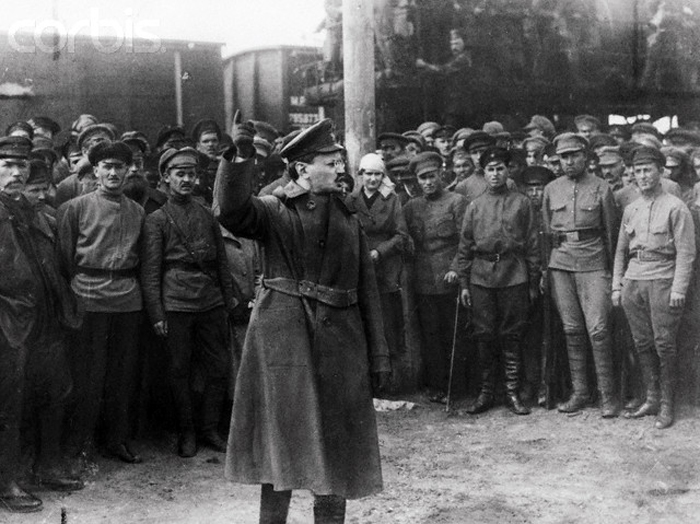 In April, Trotsky was appointed Commissar of War. He was determined to create a disciplined armed forces, in sufficient numbers and led by competent officers / Image: public domain
In April, Trotsky was appointed Commissar of War. He was determined to create a disciplined armed forces, in sufficient numbers and led by competent officers / Image: public domain
Trotsky’s immediate task as the new Commissar of War was to conjure a new army out of practically nothing. Of the Imperial Russian Army, only the division of Latvian Riflemen was useful and reliable, and thus retained. The remnants of Red forces opposing the Whites on the various fronts often acted as scattered bands of partisans with little control and discipline. Red forces generally were poorly trained, equipped and led. But Trotsky rapidly transformed the Red Army into a disciplined, effective fighting force comprising several Red armies fighting on multiple fronts.
Trotsky’s first pronouncements on military policy in March 1918 were directed primarily at the party and the Soviets and called for “Work, discipline and order”. He noted that, in its first assault on power, the Bolsheviks had necessarily been anti-militaristic and had pressed for democracy in the army, electing commanders and challenging orders etc. But the new situation required a new approach that would enable the workers to defeat the enemy. This meant accepting former Tsarist officers who pledged to assist the Soviet government. Not only were they skilled in leadership but also often possessed technical and military knowledge lacking in the largely working-class layers that formed the Red Guards.
However, many within the Bolshevik Party, especially the Left Communists, fiercely resisted Trotsky’s proposals. Stalin, and some of the established Red military leaders, also opposed these ideas. Lenin and a majority of party leaders understood the necessity of adopting Trotsky’s position. Indeed Lenin took Trotsky’s theme of discipline, order and utilising skills from the within the old classes and adopted it in a much wider social and economic context, supporting the use of managers, professional and technical experts in running factories and other vital parts of economic life. For Lenin, as with Trotsky, the politics of the moment dictated the course of action.
Lenin laid his plans before the All-Russian Soviet Executive in April and they agreed on proposals for military training, new disciplinary codes and utilising the skills and expertise of former Tsarist officers. On 22 April, the government set out the policies in a Decree. Under this policy, all workers and peasants who did not hire labour would receive 12 hours of training over an 8-week period every year. The practice of electing officers was abolished and refusing to obey orders became a punishable offence and capital punishment was reintroduced for the most serious breaches of discipline. In seeking to improve army organisation, Trotsky created provincial, county and township war commissariats responsible, among other things, for the general military training of the adult population.
Trotsky’s scheme for a new Red Army did not pass without serious opposition. In April 1918, when he laid his plans before the All-Russian Soviet Executive, he met with opposition from many quarters. His decision to recruit former army officers provoked much outrage from Mensheviks and Left SRs. Martov accused Trotsky of paving the way for a dictator. More seriously, there was opposition from within the Bolshevik Party. The Left Communists rejected the idea of a centralised standing army and saw the recruitment of former officers as a compromise with the old regime.
Although the party’s Central Committee backed Trotsky’s plan it was not without misgivings and much behind-the-scenes complaining. Trotsky’s position on the issue of hiring former “officers and specialists” touched on a wider issue of relations with the old order. Trotsky and Lenin recognised the reality that the new state lacked skilled professionals, technicians and managers from among the working class. The choice was to ignore the resources available and build from scratch, or to employ such resources on behalf of the revolution and use such people to help train new generations.
However, utilising these elements, who were inevitably conservative in outlook and sceptical of the revolution, carried dangers. Some officers were White sympathisers and later defected. But, in the crisis situation of the summer of 1918, the young new state had little practical alternative. To help offset the bias or deviation of the officer corps, political commissars were attached to all the levels of command in a form of dual power. To prevent officers from sabotage or deserting to the Whites, a register was kept of the officers’ families to be held as possible hostages.
The first to volunteer from the old Imperial Army was General Bonch-Bruevich, who was made head of General Staff. Trotsky discussed with other officers and they came over later in April. At the same time, Trotsky always sought to appoint communists and revolutionaries as officers if they had proven to be effective and disciplined leaders in military combat. Nevertheless, eventually the majority of officers were from the old army, and by the end of 1918, 30,000 former officers of the Tsarist Army were serving in the Red Army. Some proved to be traitors or unreliable and Trotsky used serious disciplinary measures if they stepped out of line, including the death penalty and using the officers’ family as hostages.
As well as creating a strong and centralised army, Trotsky set about establishing improved administration, equipment and supplies. In the conditions of 1918, this was difficult but gradually began to have an impact. This was greatly aided by the fact that Trotsky’s Deputy at the Supreme War Council, directing its day to day activities, was the brilliant organiser Sklyansky, whom Trotsky described as the Carnot of the Russian Revolution (Lazare Carnot was dubbed “the Organiser of the Victory in the French Revolutionary Wars” following the French Revolution of 1793).
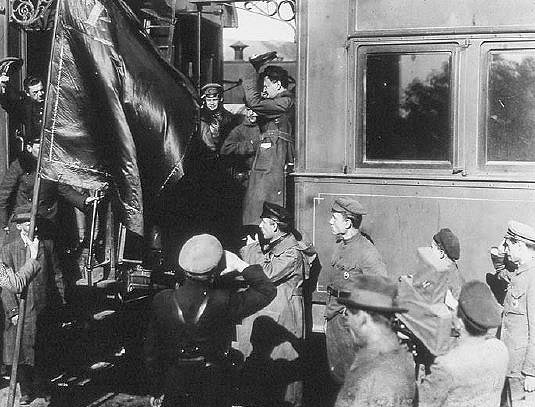 By mid-1918, efforts to re-organise and invigorate the Red Army were still on-going and meeting resistance / Image: public domain
By mid-1918, efforts to re-organise and invigorate the Red Army were still on-going and meeting resistance / Image: public domain
Finally, Trotsky laid great store in developing intensive educational and propaganda programmes to instil into the new army conscripts a spirit of commitment and devotion to the cause of the revolution. Agitprop techniques in drama, poster art and other methods were an integral element in creating a determined mood in a fighting, disciplined Red Army.
Forging an effective army was one matter but Trotsky also succeeded in reorganising the whole supply and administrative apparatus; again, not without struggle. Once the scale and urgency of the situation was realised, he was able to convince the government of the need to ensure the army was properly equipped and armed. This took time, but the process was started as soon as he took over as amy supremo. It was also quickly realised that a volunteer army was going to be insufficient to build the army rapidly to the level needed. This became apparent by the summer of 1918 and measures of conscription were introduced for working class and peasants only. Before conscription, Trotsky made appeals, especially to the Petrograd and Moscow workers, to volunteer, and many did so. These layers formed the heart of the new army, as they were committed and had self-discipline.
In May 1918, the Soviet government resorted to partial mobilisation as a response to the crisis caused by the Czech Legion turning against the Bolsheviks. The country was still war-weary and most of the peasants could not be relied upon, so the order applied only to conscript workers in Moscow and Petrograd, plus some in the regions most affected, such as the Don and Kuban areas; 51 counties in Siberia; the Urals and in the Volga Provinces. In July, orders were made to force those from bourgeois backgrounds aged 18-45 to undertake hard and dirty, non-combative tasks on the home front. This was sometimes carried out harshly. The formerly well-to-do classes in towns and countryside were forbidden to bear arms. Eventually, the principle of mobilisation was extended to young workers and peasants throughout the country. In August 1918, the Red Army numbered 331,000. This increased to 550,000 by September and 800,000 by end of the year. In October Lenin, foreseeing the end of the First World War, called for an Army of 1 million.
By mid-1918, efforts to re-organise and invigorate the Red Army were still on-going and meeting resistance. Luckily, the White forces were also ill-organised and fractious, whilst the imperial powers were still locked into the First World War. The initial foreign interventions were all peripheral at Murmansk, Archangel and Vladivostok. In central Russia, the Bolsheviks were able to consolidate their power in comparative safety.
The Czech Legion and the deepening civil war
By the end of March, Germany and her allies had occupied all the areas ceded under the Brest-Litovsk Treaty. There was no certainty they would stop at the agreed treaty line. Feeling that Petrograd was threatened, the Soviet government was moved to Moscow. One fall-out of the peace agreement was the position of a Czech nationalist force, augmented by 30,000 Czech prisoners of war, that had fought with the Russian army. They were now trapped in Russia.
Masaryk, the Czech nationalist leader, wanted to deploy them in France, so as to gain allied support for an independent Czechoslovakia after the war. To that end, he ordered them to make their way across Russia by the Trans-Siberian railway to Vladivostok for embarkation. Until this point, the relationship between Bolsheviks and the Czechs was reasonably good and there had been some collaboration against the advance of Germans into the Ukraine. But, despite an agreement on partial disarming and passage through Russia to the East, relations deteriorated. The more reactionary elements of the Czech leaders, urged on by Russian army officers who also served in the Czech army, led to resistance and a revolt by the Legion in May 1918. The British and French were only too eager to exploit Czech discontent to spark opposition to the Bolsheviks and thus establish new White fronts in the central and eastern areas of Russia. In this they succeeded. A plan by the Soviet Government to split the Czech forces as they made their way to the east led to tension, which boiled over in late May, and the Czech forces revolted, easily taking over several key towns along the Trans-Siberian railway. In many areas the Soviet power was weak and the Red forces lacked discipline and strong leadership.
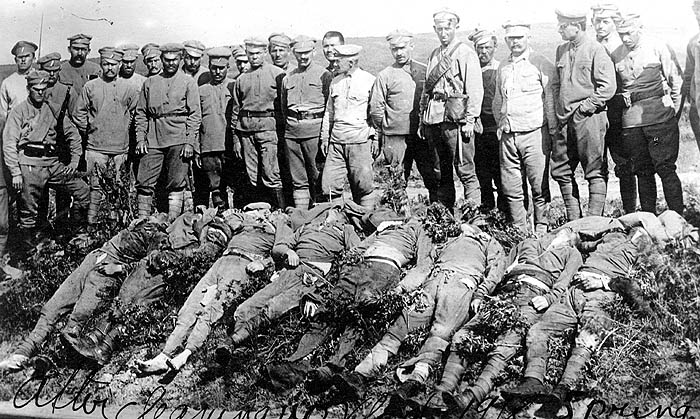 In May, the Czech forces revolted, taking towns along the Trans-Siberian railway / Image: public domain
In May, the Czech forces revolted, taking towns along the Trans-Siberian railway / Image: public domain
By June 1918, the French had moved from apparent neutrality to actively encouraging the Czech forces to stay and assist anti-Bolshevik elements. They saw the role of the Czechs to secure the Trans-Siberian railway in advance of a Japanese intervention from the East. By July, the Czech force had declared itself to be a new eastern front against Bolshevism. Resistance by Red forces in far eastern Siberia was stronger and the Czechs only managed to secure the areas around the railway near Vladivostok.
Two quasi-governments emerged following the success of the Czechs. The Western Siberian Commissariat announced its existence on 1 June. It derived its claim to authority from SRs who had been members of the Constituent Assembly. They declared for democracy, goods exchange and the re-establishment of the Constituent Assembly; and the autonomy of Siberia with its own flag. The general assessment of Siberia is that the peasants and workers were largely passive, not having the main concerns of war, hunger and so on of their western counterparts. They were not especially hostile to the Bolsheviks, but Bolshevism was weak in these territories. The initial Western Siberian Government, which had a radical tinge, was soon replaced by more conservative and reactionary elements and by July a purge and oppression of soviets and left elements began in the areas under its control.
The second quasi-government to emerge in the central/eastern region became known as the Samara Government, after a town in the Middle Volga where it was set up. Initially comprising SR Party activists it joined up with parts of the Czech Legion and rapidly spread its power over a wide area: including Lenin’s birthplace, Simbirsk. From this base, they advanced into the Urals, eventually taking the key city of Kazan by August. This was a bad blow to the Soviet government, as a large part of the state gold reserves had been placed there. This massive resource became available to the counter-revolution and helped to extend the civil war.
The military picture in this cockpit of Russia was very confusing and the fronts were partial and jagged, constantly changing, with Red and White forces occupying adjacent areas. Whilst there was some anti-Bolshevik sentiment amongst some privileged workers there was no general enthusiasm for reaction. The number of forces in operation this summer were generally small, some 65,000 red troops and 50,000 Czech and allies on the other side.
Imperial intervention
The capitalist powers were clearly horrified by the October Revolution and refused any official recognition, withdrawing ambassadors and so on. But they were desperate to try and keep Russia in the war, fearing that Germany and other central power forces, currently entrenched in various eastern fronts, might suddenly be able to move troops to the western front. The various agents and envoys of the imperialist powers who were in Petrograd and later Moscow sought to lessen their hostility to the Bolsheviks and provide vague promises of help in the hope of at least delaying the withdrawal of Russia from the war. The USA had entered the war on the side of the UK and France in April 1917 but was, on the face of it, less reactionary than the older imperialist powers. Trotsky and others thought that they might be able to drive a wedge between the USA and the other allies but in the end, this proved fruitless.
From the outset, the allies used their agents and contacts inside Russia to try and encourage opposition to the Bolsheviks. This became clearer after the Brest-Litovsk Treaty. They began plotting and scheming and gave active encouragement to armed resistance and to the emerging White forces, which they armed and supported. In addition, they established a trade embargo on Russia, blocking all the ports.
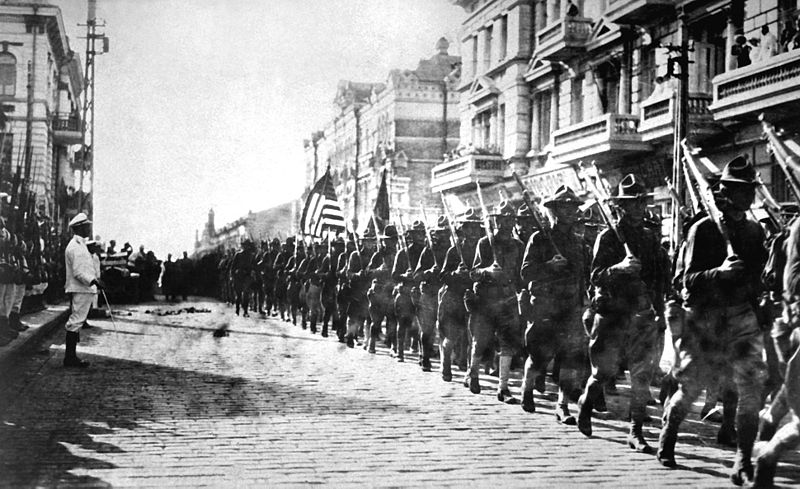
The summer of 1918 saw the real commencement of international capitalism organising to crush revolutionary Russia. On 3 August, Japanese and British troops landed in Vladivostok, quickly followed by an American regiment from the Philippines and a French force from Indo-China. Whilst the western allies were content to simply secure a bulkhead in the east, the Japanese had greater territorial designs and sent 70,000 troops. Allied intervention began to materialise more clearly in late June. The British had a base in Murmansk on the White Sea in the far north of Russia, which the Bolsheviks had tolerated. It was established during the war with Germany as a supply base with a small detachment of troops. In late June, the British started a more aggressive role by concluding a separate agreement with the Murmansk Soviet, which was not loyal to Moscow, and extended their sphere of operations south to Kem.
Rumours spread that Archangel would soon also be occupied by the British. Trotsky issued an order forbidding travel to Archangel, Murmansk or the region of Czech revolt without written permission. On 24 July, the missions of Allied powers, which had taken residence in Vologda when the Germans threatened Petrograd, now moved to Archangel. A British expeditionary force occupied Archangel on 2 August. This was timed to coincide with an uprising of anti-Bolshevik elements in the port. At the same time, the USA and other allied powers announced their intention to further intervene in Russia’s Far East. Russia became beleaguered and isolated.
Social unrest and the demise of the Left SRs
As part of the growing tension of famine and other shortages there was a declaration of martial law from 29 May 1918. This was occasioned by the Cheka discovering the plot by the Defence of the Motherland and Freedom Front that involved former officers of the army. Over 100 were arrested, but the plot leaders, including Savinkov, escaped. In June, there was an armed uprising in Tambov and a brief overthrow of the soviet. But the city was re-taken 2 weeks later and the insurgents shot. In July, there was another serious uprising led by Savinkov in the Volga town of Yaroslavl, which was eventually retaken. Savinkov later said he was supported and encouraged by the French, who at this stage were the leading capitalist power in favour of more direct intervention against the Bolsheviks. The action in the Upper Volga was intended to coincide with the Allied invasion of Archangel (which took place in August).
Two centres of disaffection developed in Petrograd: the Obukhov factory, where the SRs held continual meetings denouncing food shortages, and at the torpedo-boat squadron of the Baltic Fleet, where officers and men were enraged by rumours that the government intended to disband the fleet. The disarming of both took place without bloodshed. Admiral Stchastny was denounced by Trotsky and later shot. Some isolated groups of workers were persuaded to revolt by Menshevik and SR agitators. But these proved fleeting episodes. The most serious difficulties occurred with the railway workers. States of emergency had to be declared on some lines. In some cases shots were fired and stoppages took place. The Mensheviks and SRs attempted to exploit the situation and even tried to organise a conference of non-party workers, but to no success. Workers might grumble or even strike against intolerable food shortages but they had no desire for an overthrow of the regime and had no confidence in either the SRs or the Mensheviks.
 The Left SR, Muraviev, defected and tried to incite an anti-Bolshevik insurrection. He failed, and the Left SRs were finished / Image: public domain
The Left SR, Muraviev, defected and tried to incite an anti-Bolshevik insurrection. He failed, and the Left SRs were finished / Image: public domain
The heightened tension and the various plots led to a growth in Cheka activities and increasing repression of opposition. Arrests were made, not just of officers and other classes deemed counter-revolutionary, but also some Mensheviks and SRs. In June, the All-Russian Soviet Executive Committee decided to expel all Right SRs and Mensheviks from its membership and instructed all local soviets to do likewise. This was a response to the fact that the SRs and Mensheviks were now collaborating with the counter-revolution.
At the 5th All-Russian Soviet Congress in early July, the Left SRs were in disagreement on three points. They wanted to tear up the Brest-Litovsk Treaty and resume war with Germany. They opposed the Committees of the Poor and finally were against courts having the right to impose the death penalty (even though they included individual terrorism in their programme and participated in the work of the Cheka, where the death penalty was meted out). Their resort to terrorist activities, such as the shooting of Volodarsky, a prominent trade union and Communist leader, led them up a blind alley. The best elements in their membership joined the Communist (Bolshevik) Party and others ended up alongside counter-revolutionaries. One of the last acts was by the Left SR Muraviev, who was a Soviet Commander on the Volga Front. Taking some troops with him, he defected to the counter-revolutionary side at Kazan and then went to Simbirsk where he tried to urge troops there to join against the Bolsheviks. But the majority held and he was either killed or committed suicide. Left SRs were henceforth not tolerated on any Soviet.
Turning of the tide
The last few months of 1918 were no less tumultuous than the earlier part of the year. The civil war dominated all aspects of life, intensifying on several fronts. The pressures of counter-revolution at home also increased, with attempted assassinations of leading Bolsheviks and countless plots by Cadets, SRs, Anarchists and Mensheviks.
The Entente powers – Britain, France, the USA and others – moved from indirect interventions to direct invasions of Russian territory. All efforts to create a socialist economy and administration were severely hampered by war, famine and dislocation. The response of the Soviet regime was to assume greater central powers economically, socially and politically; and also to combat terror with some degree of repression. This phase has become known as War Communism. The end of the First World War in November 1918 marked a significant change in the situation, leading to greater hopes for a German socialist revolution and the ability to re-take some lost territory. However, the imperial powers also felt able to increase their efforts to topple the Bolsheviks.
War Communism
The series of sharp crises that beset the Soviet government from April 1918 onwards forced a change of direction in terms of centralised control and draconian measures. In large part, this was a necessity borne out of war: both the imperialist world war and the ongoing and intensifying civil war.
All countries that have been engaged in war in the modern era have been forced to adopt measures of control, direction and requisition. Russia in the spring and summer of 1918 was no exception. It was suffering unparalleled difficulties in terms of access to resources – especially food – a chaotic and disrupted distribution system, declining production and the increasing demands of mounting a full-scale military response to a counter-revolution backed by foreign imperialism. In addition, the international blockade imposed on Russia prevented normal trade and the ability to obtain resources from abroad. All these factors led to a series of new measures in the late spring, summer and autumn of 1918 that continued until after the civil war. Collectively, these measures have been dubbed “War Communism”.
The basic outline of war communism started in late March with the ending of workers’ control of the state railways and the adoption of strong centralised and disciplined management. This was followed in April 1918 with the nationalisation of external trade: a direct response to the international trade blockade. Also in April, compulsory military training was instituted for all (working-class) men between the ages of 16 and 40. In May, a decree was passed abolishing the right of inheritance. Assets worth over 10,000 roubles would revert to the state on one’s death. In June, measures to forcibly requisition grain from rich peasants were instituted. Among the steps taken was the formation of Committees of Poor Peasants, which were to assist Food Brigades sent from the urban areas to identify and seize grain stocks, by force if necessary. Many severe battles took place in the process of implementing this policy.
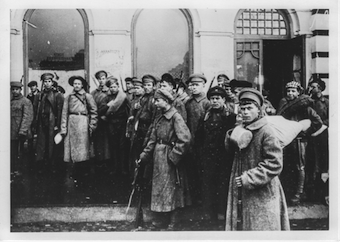 The crises from April onwards forced centralised control and draconian measures: "War Communism" / Image: public domain
The crises from April onwards forced centralised control and draconian measures: "War Communism" / Image: public domain
Under a decree passed in April, consumers’ cooperatives were given a central role in economic life and allowed a degree of independence. In June this was curtailed through a series of measures designed to bring this sector firmly within the control and direction of the Supreme Economic Council and its lower tier structures. In May, the sugar industry was nationalised and later, in June, a decree was passed allowing for the nationalisation of all big industry. This was implemented gradually over the summer months. The ability to manage such nationalised industries posed a major problem and eventually involved hiring several old managers and supervisors, a policy not without opposition from within the party.
Whilst for Lenin and Trotsky, and the majority leadership of the Bolsheviks, War Communism had become a necessity and likely to be temporary, for the left communists it was the programme for which they had been arguing for some time. They saw it as the long-term solution to establishing socialism in the Soviet Union and a vindication of their position. Many left communists decided they could no longer sustain the faction and it petered out in the autumn of 1918. War Communism continued through the long years of the civil war, finally being superseded by the New Economic Plan of 1921.
The civil war
The changing fortunes and sheer scope of the civil war are complex. While the details are not uninteresting they are beyond the scope of this article to describe. Suffice it to say that the war was a highly mobile one that did not involve huge armies in any one place, but overall embraced hundreds-of-thousands of Red and White forces (as well as the latter’s allied imperialist forces). It was also extremely brutal and many lives were lost, although famine accounted for even more deaths.
By the summer and autumn of 1918, the Soviet regime was beset on all sides by hostile forces. In the north, British, French and allied forces linked up with local reactionary groups to occupy parts of Russia around Murmansk and Archangel. In the west, the Germans occupied the Ukraine, White Russia, Finland and the Baltic States as well as threatening Petrograd. To the south, another extended military front stretched from the southern Ukraine into the Caucasus and thence the Don region. The French, British, Rumanian and other countries were involved in this region. In the east, the Japanese, USA and others held an enclave around Vladivostok and sought linkages with other fronts further west in the Urals that had been prompted by the success of the Czech Legion along the Trans-Siberian railway.
The threat of counter-revolutionary terrorism and Red Terror
The shooting of Lenin and Uritsky and the plan to assassinate Trotsky led to a sharp reaction from the Soviet government in the form of a decree on 5 September 1918 organising a period of Red Terror. This decision was predicated on the understanding that the August attacks had been coordinated and planned as part of a wider, de-stabilising effort by imperialist and counter-revolutionary forces. Certainly the French and the British had been involved in these plots and Bruce Lockhart, a British agent, was arrested. The decree was uncompromising and called for “an end to this clemency and slackness”. It went on to call for the immediate arrests of all known Right SRs and for large numbers of hostages to be seized from the ranks of the bourgeois. At the least sign of White resistance or activity, mass shootings were to be the rule.
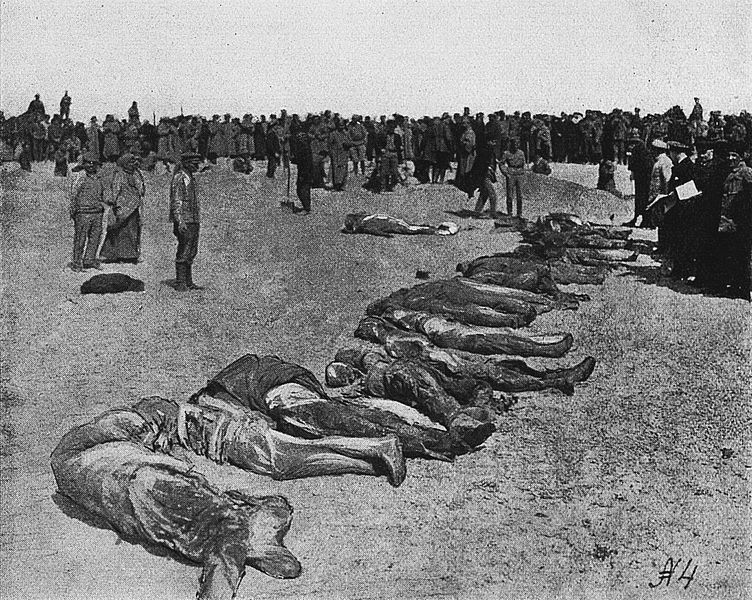 The shooting of Lenin and Uritsky and the plan to assassinate Trotsky led to a sharp reaction from the Soviet government in the form of a period of Red Terror / Image: public domain
The shooting of Lenin and Uritsky and the plan to assassinate Trotsky led to a sharp reaction from the Soviet government in the form of a period of Red Terror / Image: public domain
These measures were carried out in all Soviet-held areas. Over 500 counter-revolutionaries were shot in Petrograd and many grand dukes, officers, industrialists, bankers arrested as hostages. At Krondstadt, a further 500 were shot. Elsewhere, there was a much-lower level of shooting. Although the Red Terror slackened off it did not cease, largely because the White Guards and their allies, the bourgeoisie in the towns and cities, continued to plot, plan and fight for counter-revolution. In a sense this was a heightened internal class war, in much the same way as the raging military battles being fought all around Russia. Victor Serge pointed out that, in the first six months of 1918, the Cheka executed only 22 people. In the last six months, in response to the growing threat, there were more than 6,000 executions covering both counter-revolutionary activity and criminal offences. This represents a considerable increase but in the grand scheme of things, and set beside the untold thousands of workers and peasants killed by the White forces in numerous massacres and atrocities, it is possible to see it, within a war environment, as commensurate.
Crisis on the Eastern front
The loss of Kazan to Czechs and other anti-Bolshevik forces in August sent alarm bells ringing in the Kremlin. The counter-revolution now threatened the heartlands of Russia. The area between Kazan and Moscow was relatively open and not easy to defend. The Red forces under Vatsetsis, the Commander of the eastern front, had been routed. Vatsetsis gathered those who remained at Sviazhsk (a small town, 40 miles west of Kazan on the Volga) and dug in.
Trotsky rushed to the scene with 200 hand-picked communists in an armoured train, later to become one of the enduring symbols of the civil war. He set up his headquarters at the railway station in Sviazhsk and set about galvanising Red forces with a blend of intensive propaganda and iron discipline. He also brought in fresh troops and supplies by rail, overcoming the numerous attempts at sabotage by railway workers along the route. His train carriage became the hub of organisation and discipline. Trotsky led by example, taking part in a daring raid on the White fleet of ships on the Volga, setting them all ablaze and thus setting the basis for the re-taking of Kazan by 10 September. This was clearly a turning point on the eastern front and secured the heartland of Russia. The Red forces were now able to take the offensive. Simbirsk was re-taken on 12 September under the leadership of brilliant new Commander of the First Army, Tukhachevsky. The Samara government was now in disarray. On 3 October, Syzran was re-occupied and on the 8th, Samara itself fell. The Samara government retreated east of the Urals to Ufa and was then swept out of existence by a coup from Admiral Kolchak in Omsk in November. The Red Army maintained a steady advance on this front, taking various towns and areas to the east until the end of 1918.
The capture of the Volga region was not just an important psychological victory, it gave access to some good, grain-yielding areas and the important Volga transport system. Trotsky had shown himself to be a brilliant organiser and strategist as well as an inspiration to the troops. After these successes, he returned to Moscow and set about reorganising the Supreme War Council into the Revolutionary War Council with powers to decide matters of military policy. Under it, he established Revolutionary Councils of War for each of the 14 armies, each council consisting of the commander of the army and two or three commissars. On the War Council, Trotsky included many of the key figures who had shown special merit in the Urals and Volga campaigns.
The Southern Front and early clashes between Trotsky and Stalin
Following their defeat in the Volga and the Urals, the Whites had their main strength in the Cossack country of the Don in the south, led by General Krasnov, who had been foolishly released by the Bolsheviks after his failed attack on Petrograd shortly after the revolution. With the support of the Germans, Krasnov established a quasi-autocratic Government of the Don. Further south in the Kuban, another Cossack area, the leader was General Denikin, who was bitterly opposed to Krasnov. Divisions within the White forces were an abiding feature of the war and proved to be one of the critical factors in the outcome.
The Bolsheviks had been defeated in the main Don city of Rostock and in other towns. There were roving bands of red partisans but no significant force within the region itself. Reprisals and brutality against workers who supported Bolsheviks were extreme. The southern front lay broadly to the north of the Don region, abutting the Volga region. Here, the chief Red commander was Voroshilov, who led the Tenth Army, and whilst bravely resisting the advance north of Krasnov, resisted instituting the changes that Trotsky sought in the organisation and discipline of the Red Army. There is no doubt that the situation in the south was complicated. The Cossacks were strongly divided between rich and poor, the rich favouring the Whites, the poor the Reds. Often villages took different sides.
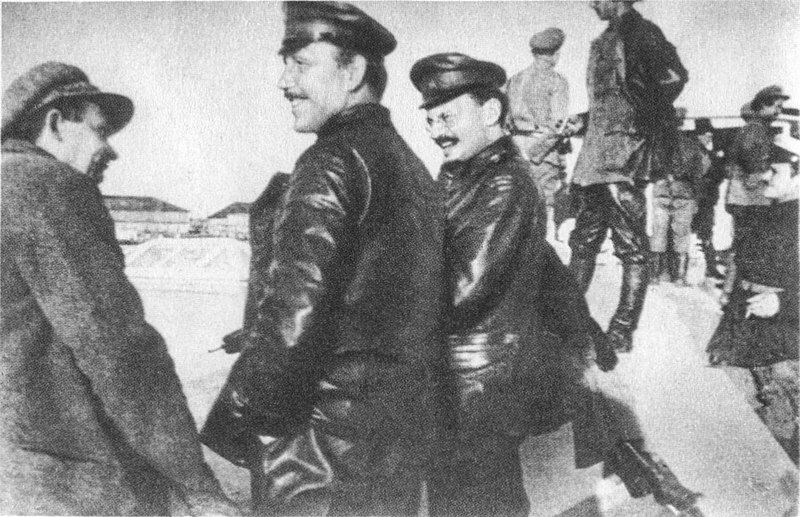 The machinations of Stalin and the Tsaritsyn group against Trotsky anticipated the conflict to come / Image: public domain
The machinations of Stalin and the Tsaritsyn group against Trotsky anticipated the conflict to come / Image: public domain
There were many separate bands of Red partisans and a culture of guerrilla warfare rather than the centralised, organised approach that Trotsky sought. Voroshilov’s resistance to Trotsky’s reforms received backing from Stalin, who was in the areas organising grain requisitions. Later in September, Stalin acted as the chief political commissar for the whole southern front, leading to constant friction between the front and the army headquarters in Moscow. In order to resolve the situation, Trotsky took strong action that clearly marked a step in the developing antagonism between Stalin and Trotsky. At the beginning of October, Voroshilov was replaced as southern front commander by Sytin, a general of the old army, and Stalin was replaced as chief commissar by Shlyapnikov. As compensation, Stalin was appointed to the Revolutionary War Council and returned to Moscow. Conflict with Voroshilov reached a pitch and Trotsky threatened him with court-martial.
Trotsky spent the rest of the autumn and winter on the southern front. Stalin began to intrigue against Trotsky, even seeking to draw in Lenin, who refused. The role of Stalin in intriguing against Trotsky in Moscow and seeking to influence Lenin started here. Trotsky challenged Lenin on the issue and Lenin accepted there was such an intrigue but stated he had full confidence in Trotsky. Eventually, Trotsky insisted that Voroshilov be withdrawn and deployed in Ukraine. Lenin agreed. The left communists under Bukharin also intrigued against Trotsky, whom they saw as authoritarian and contrary to their libertarian ideals.
The machinations of Stalin and the Tsaritsyn group (Vorolishilov and other Red leaders from the old leadership in the south) reached a new pitch in December 1918. In a remarkable early anticipation of the slanders that were to come, they accused Trotsky of being the friend of Tsarist generals and of persecuting Bolsheviks in the army. These contrived stories found their way into Pravda, edited (as we have noted) by Bukharin. Moving to another level, two members of the Central Committee, Lashevich and Smilga accused Trotsky of sending commissars and communists to the firing squad. Trotsky replied to these stories in a confidential letter to the Central Committee at the end of December 1918, saying that only one commissar had been executed and that was for desertion, and went on the defend himself vigorously. Trotsky further took up this matter in a piece he published in 1919, called “Letter to a Friend”.
End of First World War and the German Revolution
The end of the First World War in November 1918 marked a decisive change in the situation. As part of the armistice agreement, Germany had to withdraw from all occupied territories and this it immediately began to do. But, while 11 November marked the symbolic end to the war, the defeat of the Central powers been apparent to many by the late summer. Austria, on the verge of collapse, was seeking peace as early as September. In early October, a new government came to power in Germany led by Prince Max of Baden as Chancellor and Scheidemann, the Social-Democrat, as Vice-Chancellor. The central powers made a joint proposal for an armistice to President Wilson, but discussions dragged on. Meanwhile, risings took place in Vienna and Budapest. Soviets began to be established in Germany and Austria. The Kaiser, refusing to abdicate, urged a last effort by the navy. This was thwarted by a mutiny and general strike in Kiel. The Kaiser was forced to abdicate and fled to Holland on 9 November. Under major pressure from a growing revolutionary wave, especially in Berlin and other major cities, a new Social Democratic Government was formed, calling itself (as a bluff) the Council of People’s Commissars.
While all this was going on, the excitement among the Bolsheviks in Russia was mounting. At long last, the expected workers’ revolution appeared to be taking place in Germany and Austria, and would surely be followed in France and Britain. Lenin, at this time, had just about recovered from the wounds inflicted by the attempted assassination of 30 August. The Soviet Executive pledged full support to the proletariat of Germany and Austria, instructed the Revolutionary Military Council to expand the formation of the Red Army and to set up food funds for the German and Austrian workers. Lenin addressed a meeting of the Soviet Executive at the end of October, stating that we had “never been so near a world revolution and never have we been in such a perilous position, because this is the first time that Bolshevism has been regarded as a world-wide danger.” The imperialists were undoubtedly emboldened by their victory over Germany and her allies and wanted to strike at Russian Bolshevism. But, they were hampered by two big factors. First, the war weariness of their troops and secondly, the growing sympathy of their working classes to Bolshevism and revolution.
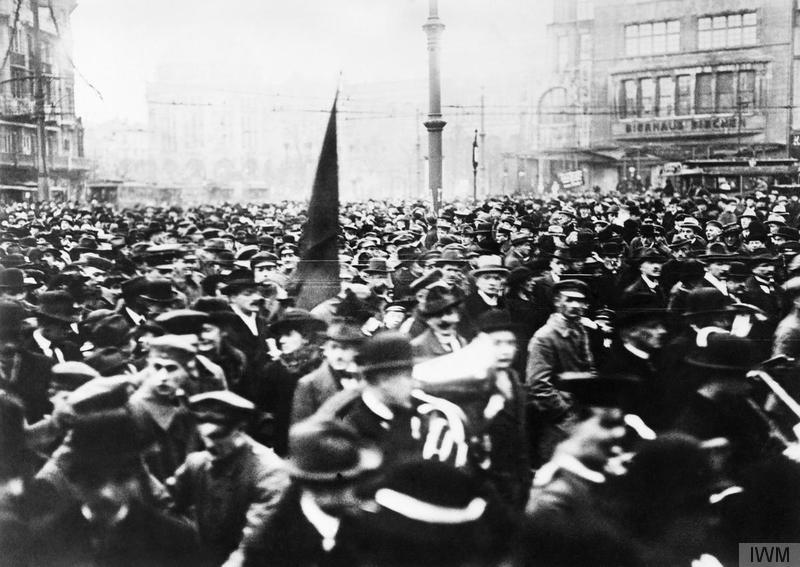 At long last, the expected workers’ revolution appeared to be taking place in Germany and Austria. It seemed the Soviets' isolation would finally be broken / Image: public domain
At long last, the expected workers’ revolution appeared to be taking place in Germany and Austria. It seemed the Soviets' isolation would finally be broken / Image: public domain
Although Austria and Germany were ripe for revolution, one major obstacle stood in the way and that was the treacherous role played by the German and Austrian Social Democratic Party leaderships. Allegiance to revolutionary parties was growing rapidly but had not achieved what we might call critical mass. The repression of revolutionaries in Germany had taken its toll and the social democrats continued to carry the mantle of Marxism when it suited them. The release from custody of Liebknecht and Luxemburg in Germany, and Adler in Austria, in October 1918 was important but gave insufficient time to develop a significant mass revolutionary force to meet the wave of discontent at the end of the war.
The Bolsheviks tried their best to influence events in Berlin in November and December 1918, but the opposition of the German government, dominated as it was by social democrats, by and large frustrated their efforts. Joffe, the Soviet Ambassador to Berlin, was expelled on 5 November and diplomatic relations with Russia severed. Although Russia had sent clandestine support to the Spartacists (the German version of the Bolshevik Party) the strength was with the moderate socialists, backed by reaction as their best bet to stave-off revolution. But, more was needed to prevent revolution, and that was to drown the growing wave of revolt in blood. Noske, the SDP minister in charge of internal security, was to take up that task, as he demonstrated in January 1919. The murder of Liebknecht and Luxemburg, also in January 1919, effectively removed the best and most inspirational Spartacist leaders.
Escalation of imperial intervention
Once it was clear that Germany was going to be defeated in the war, France, Britain, the USA and the other allied powers stepped up both their support for the Whites and their direct intervention with troops. As Lenin had predicted, they now saw Bolshevik Russia as a dangerous example that had to be squashed, lest it infect their own countries. The British, French and Japanese had all landed forces in Russia earlier in 1918. The British and French in the northern sector had bases established in the First World War at Murmansk and Archangel, and the Japanese at Vladivostok. The Czechs were already a significant force within Russia, as has been discussed.
Allied interventions became much more serious in the summer of 1918 and Special Expeditionary Forces were established by France, Britain and the USA to strengthen their involvement. Other nations also sent small units. By the end of 1918, Russia was encircled by fronts that had both direct and indirect allied support.
The western Siberian front, where the Bolsheviks mostly clashed with the Czech legion, has already been discussed. The eastern Siberian zone was largely confined to an area around Vladivostok. British, Japanese and US warships had been sent there early in 1918 and the British and Japanese landed small forces. This was stepped up considerably in the summer of 1918, with 70,000 troops from Japan and then an international coalition of 25,000 troops from the USA, Britain, France, Canada, China, Romania, Serbia and Italy.
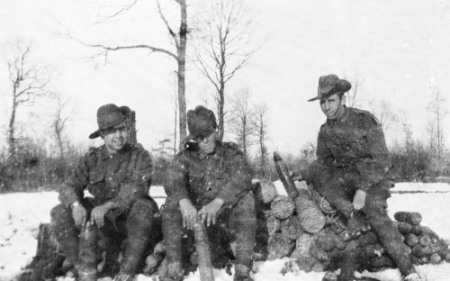 Allied interventions became much more serious in the summer of 1918 (Australian soliders pictured) / Image: public domain
Allied interventions became much more serious in the summer of 1918 (Australian soliders pictured) / Image: public domain
On the northern front, Britain and France had established armed depots storing military equipment and ammunition at the ports of Murmansk and Archangel in 1917 as part of the First World War efforts to strengthen Russian resolve. From the summer of 1918, the French and British and later the USA formed the Northern Expeditionary Forces of army, navy and airforce units designed to protect their supplies and to assist the Whites, especially the Czech Legion. The Canadians, Australians, Serbians and Poles also sent supportive units. In August and September 1918, these allied forces began an offensive into Bolshevik-held territory. The Bolshevik forces, however, had managed to force them back to an area just 50 miles south of the two ports.
A Baltic campaign was conducted by the British and other navies towards the end of 1918, to assist White forces in Estonia and Latvia. In December 1918, the French began a direct intervention in southern Russia, occupying Odessa on the Black Sea. The French were supported by Polish and Greek troops.
In the southwest, Romania had annexed Bessarabia (equivalent today to Moldavia and parts of the Ukraine) in March 1918.
The South Caucasus region of Russia, comprising the countries of Georgia, Armenia and Azerbaijan, was of particular interest to several countries, notably Turkey, who claimed Armenia; and Britain and Germany, who were keenly interested in the oil fields of Azerbaijan, centred on Baku. At the end of 1918, the British recognised the independence of Azerbaijan and Georgia, both hostile to the Bolsheviks, and sent troops to Baku to protect oil supplies and to prevent oil reaching the Reds.
There were also operations conducted in central Asia by the British. In February 1918, the Red Army overthrew the White Russian-supported Kokand autonomy of Turkestan. Allied forces began to intervene and British forces, led by Major Dunsterville, drove the Bolshevik forces out of central Asia. But this success was short-lived, and soon Dunsterville was himself forced back. The Bolsheviks continued to make progress in bringing the central Asian population under their influence. The first regional congress of the Russian Communist Party was convened in the city of Tashkent in June 1918, in order to build support for a local Bolshevik Party.
The end of 1918
When the Sixth Congress of the Soviets met between the 6-9 November 1918, to mark the first anniversary of the revolution, the mood was upbeat. The First World War had not yet stopped but it was clear that it soon end, and the hopes for world revolution looked promising. This is the opening of Lenin’s address to the delegates:
“(Comrade Lenin’s appearance in the hall is greeted with prolonged ovation) Comrades, we are celebrating the anniversary of our revolution at a time when events of the utmost importance are taking place in the international working-class movement. It has become obvious even to the most sceptical and doubting elements of the working class and working people in general that the world war will end neither by agreements nor by coercion on the part of the old government and the old ruling bourgeois class, that this war is leading the whole world as well as Russia to a world proletarian revolution and to the workers’ triumph over capital.
“Capital drenched the earth in blood, and, after the violence and outrages of German imperialism, Anglo-French imperialism, supported by Austria and Germany, is pursuing the same policy.
“Today, when celebrating the anniversary of the revolution, it is fitting that we cast a glance back along the path traversed by the revolution. We began our revolution in unusually difficult conditions, such as no other workers’ revolution in the world will ever have to face. It is therefore particularly important that we endeavour to review the path we have covered as a whole, to take stock of our achievements during this period, and see to what extent we have prepared ourselves during the past year for our chief, our real, our decisive and fundamental task.
“We must be one of the detachments, one of the units of the world proletarian and socialist army. We have always realised that it was not on account of any merit of the Russian proletariat, or because it was in advance of the others, that we happened to begin the revolution, which grew out of world-wide struggle.
“On the contrary, it was only because of the peculiar weakness and backwardness of capitalism, and the peculiar pressure of military strategic circumstances, that we happened in the course of events to move ahead of the other detachments, while not waiting until they had caught us up and rebelled. We are now making this review so as to take stock of our preparations for the battles that will face us in the coming revolution.
“And so, comrades, when we ask ourselves what big changes we have made over the past year, we can say the following: from workers’ control, the working class’s first steps, and from disposing of all the country’s resources, we are now on the threshold of creating a workers’ administration of industry; from the general peasants’ struggle for land, the peasants’ struggle against the landowners, a struggle that had a national, bourgeois-democratic character, we have now reached a stage where the proletarian and semi-proletarian elements in the countryside have set themselves apart: those who labour and are exploited have set themselves apart from the others and have begun to build a new life; the most oppressed country folk are fighting the bourgeoisie, including their own rural kulak bourgeoisie, to the bitter end.
“Furthermore, from the first steps of Soviet organisation we have now reached a stage where, as Comrade Sverdlov justly remarked in opening this Congress, there is no place in Russia, however remote, where Soviet authority has not asserted itself and become an integral part of the Soviet Constitution, which is based on long experience gained in the struggle of the working and oppressed people.
“We now have a powerful Red Army instead of being utterly defenceless after the last four years’ war, which evoked hatred and aversion among the mass of the exploited and left them terribly weak and exhausted, and which condemned the revolution to a most difficult and drastic period when we were defenceless against the blows of German and Austrian imperialism. Finally, and most important of all, we have come from being isolated internationally, from which we suffered both in October and at the beginning of the year, to a position where our only, but firm allies, the working and oppressed people of the world, have at last rebelled. We have reached a stage where the leaders of the West European proletariat, like Liebknecht and Adler, leaders who spent many months in prison for their bold and heroic attempts to gather opposition to the imperialist war, have been set free under the pressure of the rapidly developing workers’ revolutions in Vienna and Berlin. Instead of being isolated, we are now in a position where we are marching side by side, shoulder to shoulder with our international allies. Those are the chief achievements of the past year.”
The first anniversary celebrations in Petrograd were a joyous, informal affair featuring demonstrations, columns of marchers on the streets and squares of the city, and a military parade on Uritsky Square (formerly Palace Square). Marchers gathered under the famous Alexander Column, which avant-garde artist Natan Al'tman had converted into a mobile fabric torch.
In November, the Soviet government annulled the Brest-Litovsk Treaty. This was followed by turmoil and massive struggles in Ukraine. Lenin had originally not placed great store in resuming struggle in Ukraine, stressing the need to maintain efforts in the other fronts. Kolchak, having taken over the leadership of the eastern front, had rolled back the Bolshevik advances, re-taking Perma and Ufa, but was then held at this point. Lenin swung his support to Trotsky in the decision to make a concerted effort to retake Ukraine.
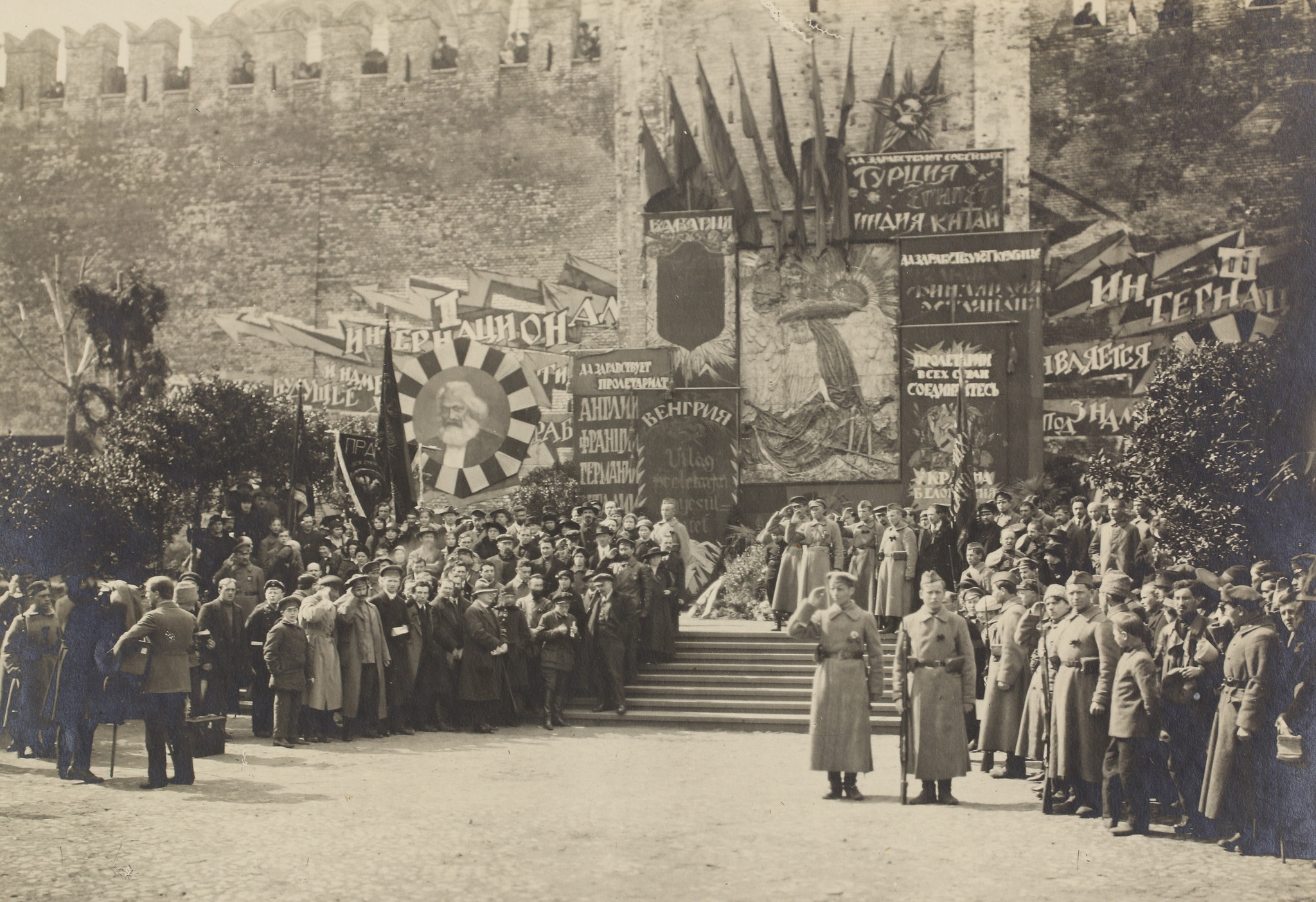 An international, revolutionary gathering took place in Petrograd in December 1918, presided over by Zinoviev. This was the prelude to the formation of a new Communist International, to be known as the Third International, whose first congress was held three months later in March 1919 / Image: Flickr, The Kathryn and Shelby Cullom Davis Library
An international, revolutionary gathering took place in Petrograd in December 1918, presided over by Zinoviev. This was the prelude to the formation of a new Communist International, to be known as the Third International, whose first congress was held three months later in March 1919 / Image: Flickr, The Kathryn and Shelby Cullom Davis Library
The German occupation disintegrated rapidly after the armistice. The old nationalists had also begun to re-group from September and had a volunteer army that fought against the Hetman, a German quisling. By the end of the year, Red partisans, with the support of anarchist bands under the general leadership of Makhno, had made considerable progress. The struggle for control of Ukraine was now a civil war between the old nationalist elements, representing the rich and middle peasantry; and the Red Army and its allies, representing the working class and poor peasants. The French, seeking to throw their support behind the nationalist Directorate, landed at Odessa in December 1918. They were supported by Greek, Romanian and Polish troops. They immediately started a march north to link up with the nationalist forces. This ill-fated campaign foundered early in 1919.
An international, revolutionary gathering took place in Petrograd in December 1918, presided over by Zinoviev. This was the prelude to the formation of a new Communist International, to be known as the Third International, whose first congress was held three months later in March 1919.
A balance sheet
In drawing up a balance sheet of 1918, the first and most important point is that, against all the odds, the Russian Revolution of October 1917 survived. Lenin held a small celebration when the revolution outlasted the three months or so of the Paris Commune. He had thought the survival of the revolution would be touch and go, as it was. But in early February 1918, when the Paris Commune milestone was passed, the forces of reaction were still gathering.
“Three or four Japanese or American divisions are enough to put an end to the Bolsheviks.” From a telegram sent by the US Ambassador in France, January 1918.
“This year will see the end of Bolshevism.” From a speech by Marshal Foch, France, February 1919.
The initial efforts within Russia by the old defeated classes to mount a counter-revolution had been decisively defeated in Petrograd and Moscow and were being overcome throughout Russia, especially in all the towns and cities. But the international capitalist class, temporarily held back by the First World War, understood the danger Bolshevism represented and after initially hoping to tame it and bend it to its will had, by the spring of 1918, embarked upon an increasingly determined policy of seeking the military overthrow of the new regime.
Initially, they armed and supplied the various ragtag and bobtail forces that represented opposition to the Bolsheviks. They weren’t particularly fussy about who got support. At one stage it might be the SRs, another the Mensheviks and eventually, more and more, the vicious reactionary generals and admirals of the old Imperial Army and Navy and their White armies. Once the fate of the First World War was known they began a more direct intervention, sending troops, ships and arms to various footholds in the peripheral areas of the north, south and east of the vast country; and even some detachments deep into Russia itself. But the emerging power of the new society, resting on the labouring and previously exploited peoples, proved too much for imperialism. By December 1918, although still beleaguered, Soviet Russia stood firm and ready to roll back the combined forces of national and international reaction.
The positive impact of revolution
The positive impact of the revolution was perhaps most apparent in giving the previously downtrodden a sense of their own worth as full and complete citizens. The raising of the status of the proletarian and the poor peasant from the bottom to the top not only created a different ethos and set of values in society it also began the process of releasing whole new layers of energy, talent and creativity. Of course, given the immediate harsh circumstances in which the revolution was born and the still harsher environment under civil war conditions that followed, the material benefits of the revolution took many years to bear fruit. But the mental slavery – of being regarded as virtually worthless, as mere serfs and wage slaves under the yoke of those who called themselves masters and lords – was broken. The development of soviet democracy, involving – for the first time – many hundreds of thousands of people in direct and (for periods), daily participation in decision making and charting outcomes, was a remarkable change for the masses.
The immediate actions of the new government in nationalising land and thereby ending the large rural estates of the aristocracy and other large landowners received a very positive response from peasants of all classes, but especially those with little or no land. It also unleashed a class struggle in the countryside between rich and poor peasants for the control of land and other resources. The Bolsheviks’ support for the poor peasants was a vital factor in securing the revolution. By the same token, the early nationalisation of the banks and some industries, along with workers’ control in the workplace, immediately raised confidence among the urban masses that their government was really on their side and fulfilled its promises. These tremendous gains for the working class help to explain the heroic sacrifices they were to make in defending the revolution, which they took ownership of and protected.
Although resources were scarce, the new state allocated these in fair and just ways. No longer did the rich take the lion’s share and leave crumbs for the rest. As the new July Constitution stated, the government’s motto was, “he shall not eat who does not work”. Although not enshrined in law and not meant to be taken literally for every age group, it provided a new spirit and intention to govern equally.
Whilst it was not possible to shrug off centuries of prejudices and inculcated attitudes overnight, immediate decrees by the Soviet regime began the process of social change. New laws, ending legal discrimination against women, gays and minority groups were groundbreaking and had an immediate impact. Equality and ease of divorce for both men and women was an important step in the liberation of women. Similarly, equality of all children born in or out of wedlock was a revolutionary step in 1917. In November 1918, Russia held its first All-Russia Congress of Working Women and Lenin gave the opening speech, in which he said:
“For the first time in history, our law has removed everything that denied women rights. But the important thing is not the law. In the cities and industrial areas this law on complete freedom of marriage is doing all right, but in the countryside it all too frequently remains a dead letter. There the religious marriage still predominates. This is due to the influence of the priests, an evil that is harder to combat than the old legislation.”
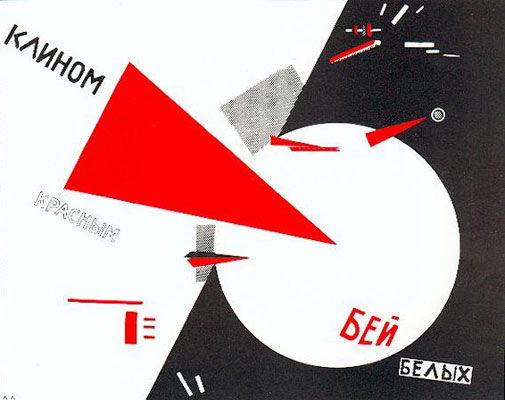 Although the arts in Russia had possessed a vibrant avant-garde before the revolution, the upheaval of 1917 gave a massive spur to new thinking and creativity / Image: Flickr, cea
Although the arts in Russia had possessed a vibrant avant-garde before the revolution, the upheaval of 1917 gave a massive spur to new thinking and creativity / Image: Flickr, cea
In this, Lenin pointed to the issue of religion; and the fact that another, early decree of the Soviet Government had been to end the entrenched position of the Russian Orthodox Church in all aspects of the state. The massive landholdings of the church had been confiscated, many of its rights and privileges ended and, although religion was not banned, it no longer held the masses in the same thrall. As Lenin said, this proved much harder to break in the countryside than the towns.
Although the arts in Russia had possessed a vibrant avant-garde before the revolution, the upheaval of 1917 gave a massive spur to new thinking and creativity. In all areas – music, literature, art, poetry and architecture – the massive changes produced shockwaves in the creative world. One of the new factors that the state and artists grappled with was how to place art at the service of working men and women, reflecting their struggles and their needs. Poster art flourished, new vibrant designs of cloth and materials also took place and agitation and propaganda became linked to the theatre in ‘agitprop’ productions. New art education was also established under avant-garde artists and architects.
The negative impact of counter-revolution and civil war
Although Soviet Russia overcame all the various crises in 1918, this success came at a price. This price was felt in all spheres: economic, social and political. In economic terms, the continued efforts to overthrow and destabilise the new Soviet government meant that the economy, already in long-term decline in any event, continued to suffer from dislocation and disruption at all levels. The disastrous Brest-Litovsk Treaty, necessary as it was, added to the economic woes by depriving the new state of vital resources. The action of Allied powers to fund and support armed opposition meant that the needs of war continued to affect production and the use of resources.
The opposition, at vital moments, of Menshevik-led railway workers meant that the distribution systems were adversely affected, particularly in the first half of 1918. The curtailing of capitalist market relations in terms of food and goods led to an acute crisis in providing sufficient food for the urban population. The rich peasants – the kulaks – refused to supply grain and other food on the terms demanded by the government and forceful methods to extract food from the countryside had to be deployed. The suffering in the cities was considerable and only harsh rationing enabled the urban populations, albeit reduced in numbers, to survive. The economic blockade instituted by the imperial Allies also limited the ability of the government to export and import.
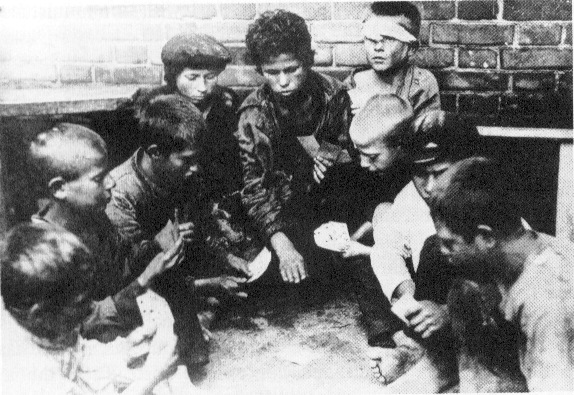
The Bolsheviks’ original plan to have some kind of transition between an outright capitalist economy and an outright socialist, planned economy had to be largely scrapped during the course of 1918 as it became clear that only a more rapid and complete transformation, placing most of the levers of power in the hands of the government, would ensure victory in these hard times. Thus, “war communism” was born and remained in place until more peaceful conditions allowed for a modified transition from one system to another. In the conditions of 1918, it proved essential to deploy, in the service of the state, specialists and professionals who carried the values and aspirations of the old system. Thus, industrial managers, administrative professionals and skilled army leaders and operators were used to assist the fledgling workers’ state overcome early deficiencies in these areas.
The growing civil war dominated life in the latter part of 1918 and over the following three years. In those areas directly affected, the impact was considerable. Many were caught up in the battles and died; others suffered great hardship and struggled to survive. In order to fight the Whites, the flower of the proletariat was drawn into the new Red Army. By the end of 1918, the Red Army was over 500,000 strong and would double again in 1919. Not only did this mean that the youngest, most energetic and most class-conscious workers were taken out of their communities and factories, but it meant many were killed or injured. The long-term impact of this on the future course of the revolution was considerable and played an important part in the eventual usurpation of power by the party bureaucracy led by Stalin. In immediate terms, it affected industrial production and the development of administrative system.
The need to combat efforts by class and political opposition to sabotage, undermine and overthrow the new soviet system led to a growth of a new state security apparatus. The Cheka began as a fairly low-key poweration and dealt relatively leniently with opposition politicians. But, as the intensity of the onslaught from all sides increased, so the Cheka expanded and its methods became more forceful. In other words, White Terror was met by a degree of Red Terror. Once dealt with, the level of repression and harshness abated. But the size and reach the Cheka had increased considerably; and developed its own layers of bureaucracy and a degree of independence that, under the control of Stalin, was deployed against Bolsheviks.
The response of the international labour movements to the revolution
The Bolshevik-led revolution in 1917 had a major impact on all socialist parties in every part of the world. But it took time to see the full effect, as the revolutionary movements were very small in most countries. In Germany, where a crisis had been brought on by their defeat in the First World War and the acute economic problems the country faced, there was a revolutionary wave, and the Spartacus League grew rapidly. But the great weight of the Social Democratic Party (SPD), so long established in the trade unions and in the working class generally, proved too powerful to overcome. The SPD played a treacherous role in placing themselves at the head of the rising, militant working class, cynically supporting the new workers and soldiers’ councils and then deploying reactionary troops to cover the tide of revolution in blood. These actions can be seen as one of the roots of fascism in Germany.
In Britain, the Labour leaders similarly sought to control a rising tide of militancy and also proclaimed themselves in support of workers and soldiers’ councils and then stalled until the mood lessened. The centre of revolutionary action in Britain was undoubtedly Scotland and especially the Clyde area. But again, the revolutionary parties were small, albeit influential, and failed to take the struggle beyond industrial militancy. The best leader by far was John McLean, appointed by the Bolsheviks as one of their British Consuls. But he was specifically targeted by the state and imprisoned several times, making his political contributions less impactful.
In France, although the mood of soldiers grew rebellious in 1917 and there were many mutinies, there was not a strong revolutionary party to offer a lead. Jaures, one of the most promising leaders, had been assassinated in 1914. Within the Socialist Party, the left were heavily defeated after the war and eventually departed to form the kernel of the French Communist Party.
In the USA, whilst the revolution had an impact on the most class-conscious workers, the main left-wing party (the Socialist Party) was dominated by reformists and the left elements were scattered and weak. The revolution helped to strengthen the genuine left and there was a rise in working-class militancy after the end of the First World War, but the state and the main trade union movement easily contained it.
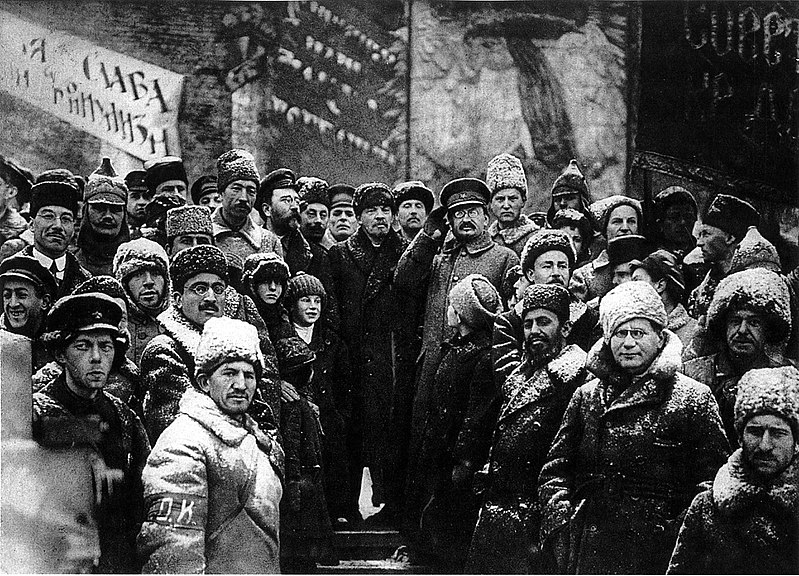 The revolution's survival through the harsh days of 1918 allowed the hope it inspired to flourish and continues to resonate to this day / Image: public domain
The revolution's survival through the harsh days of 1918 allowed the hope it inspired to flourish and continues to resonate to this day / Image: public domain
This is the immediate picture from the standpoint of the situation at the end of the first year of the revolution. In the longer-term, the impact was vast. The formation of the Third Communist International in early 1919 helped to shape the emerging post-war political scene across the globe.
The overthrow of the system of capitalist and landlord rule in Russia was like an earthquake that rumbled and shook the world for decades to come. The example inspired the Chinese Revolution and gave hope to millions of workers worldwide. Its survival through the harsh days of 1918 allowed this hope to flourish and continues to resonate to this day.

